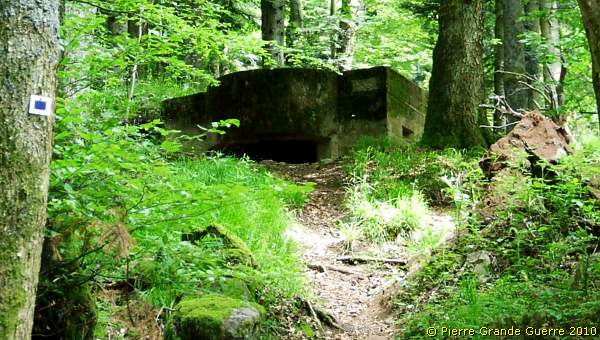ALSACE-LORRAINE - The Gap of Charmes - La Trouée de Charmes
Year of visit: 2011

This trip we start at the Léomont near Vitrimont and we will with some exceptions concentrate on the Battle of Lorraine of August-September 1914 in the area, called, the “Trouée de Charmes”, the Gap of Charmes.
After the Léomont battlefield we continue our explorations to Friscati hill and its Nécropole Nationale. Next we pay a visit to the battlefield of la Tombe to go on to the Château de Lunéville. There we cross the Vezouze to move on southward to the Bayon Nécropole Nationale. At Bayon we cross the Moselle to pass Charmes for the panorama over the battlefield from the Haut du Mont. North-west of Charmes we will visit the British Military Cemetery containing 1918 war victims. From Charmes we go northward to the battlefield of the First French Victory of the Great War, the Battle of Rozelieures of 25 August 1914. North of Rozelieures we will visit the village of Gerbéviller. From there we make a jump northward to visit the ruins of Fort de Manonviller to finish with an interesting French Dressing Station bunker, west of Domjevin.
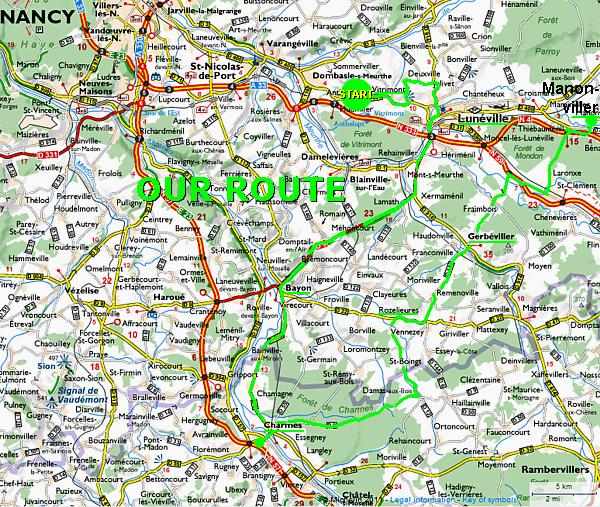
We start our trip at the battlefield of the height of the Léomont, north of Vitrimont, east of Nancy, and west of Lunéville.
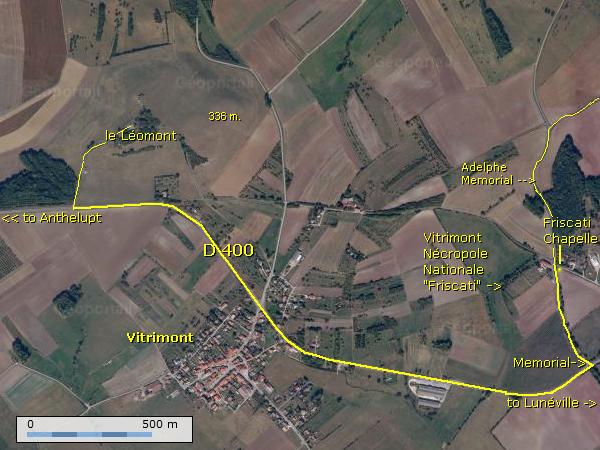

After we have parked our car, we are welcomed by this first view of the Léomont
.
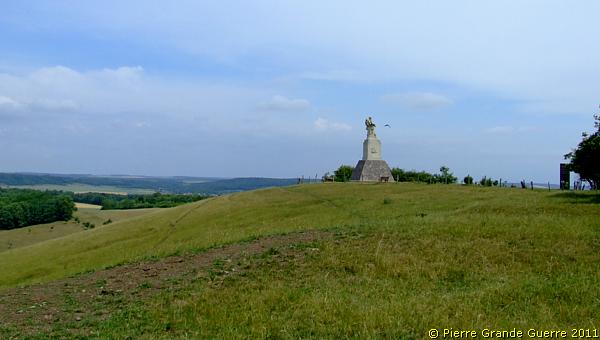
At the same location I am standing with my back to an uninteresting plot of wild vegetation, which conceals the ruins of the Farm of Léomont. A sign with a period photo tells us about the history of the Farm of Léomont.
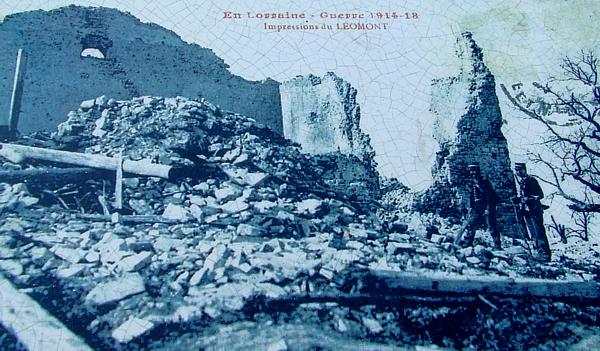
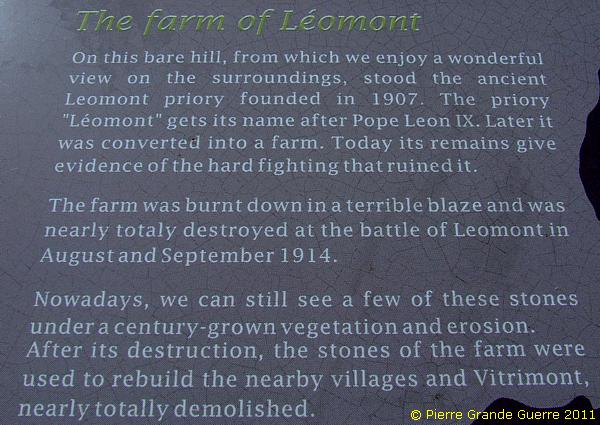
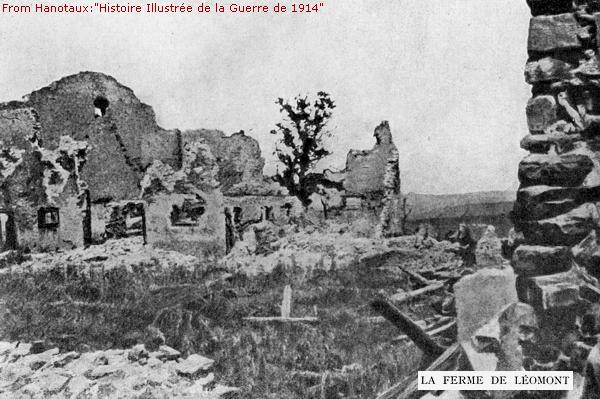
As we walk up the hill, we get a closer look at this statue of a French Soldier.
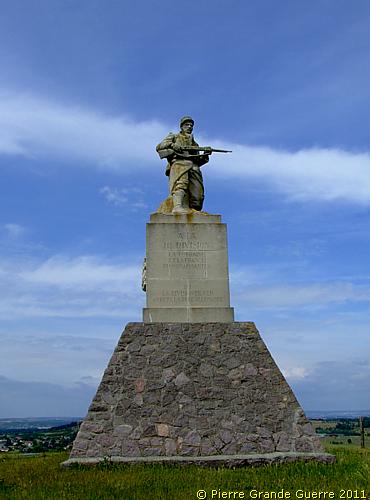
The sculptures of Gaston Broquet
Although this is a 1950 copy of Broquet's statue, the sculptor Gaston Broquet deserves some more attention. The sculptures of Gaston Broquet often show soldiers in a realistic battle situation. Gaston Broquet was a famous Lorraine sculptor, and also a war experienced Poilu, a member of the 94th R.I. See also on this website photos of other examples of Broquet's sculptures; of the wounded Sergeant Maginot near Fort de Souville , the horrified Poilu with gasmask of Samogneux , and the remarkable " Raon-l'Etape Monument aux Morts ".
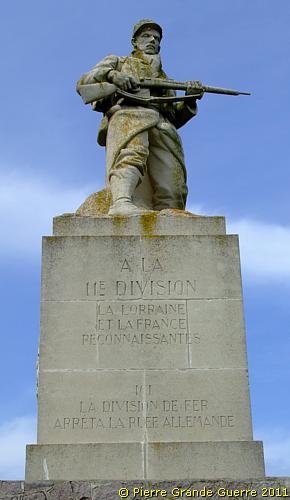
On the base of the statue are two interesting bas-reliefs, representing scenes of the battle.
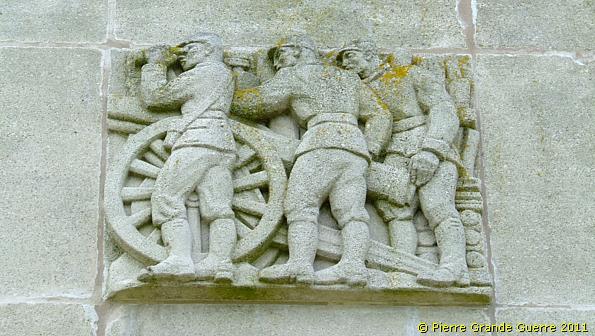
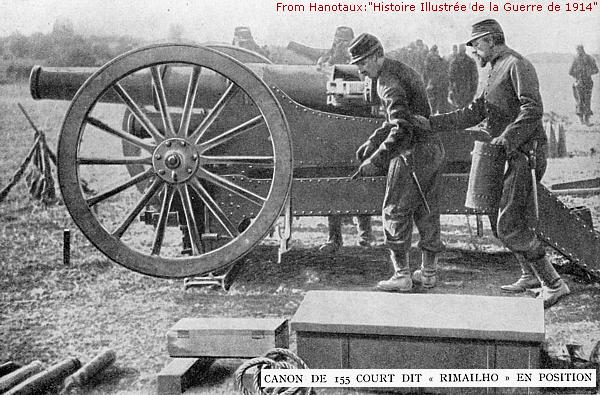
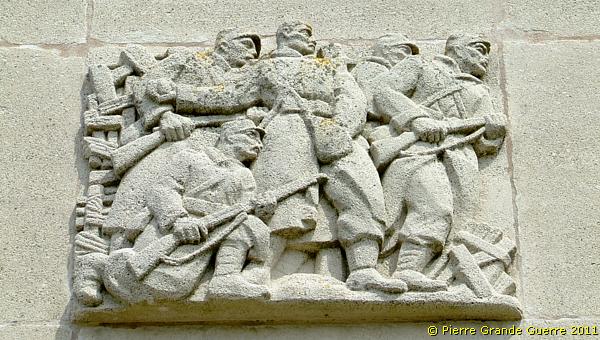
A sign tells us concisely the history of the Battle of Léomont .

The spot of Broquet's statue offers a wide panorama, fit for a first acquaintance with this battlefield.
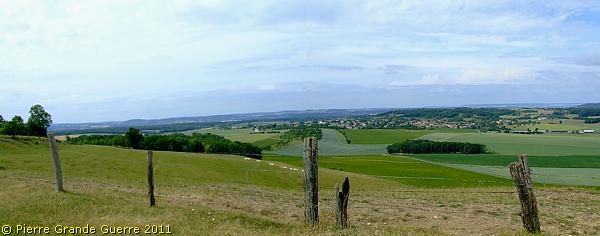
From the back of the statue we will first take look westward and north-eastward with four overlapping panorama views. Later on, after a framed intermezzo with more background information, we will continue with panoramas northward and eastward. All panoramas in this photo impression are shown in a clockwise sequence.
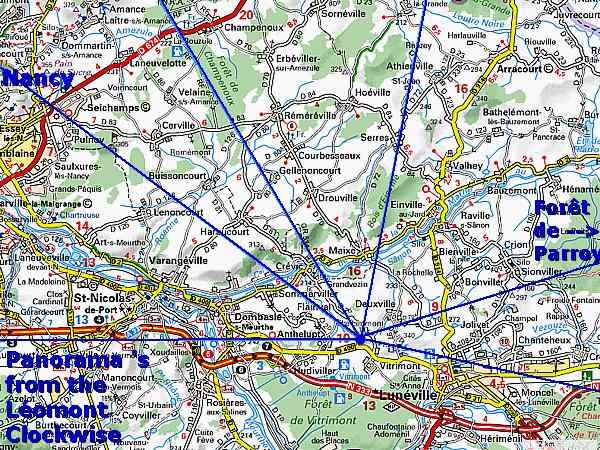
We start with a view at Anthelupt and Dombasle.

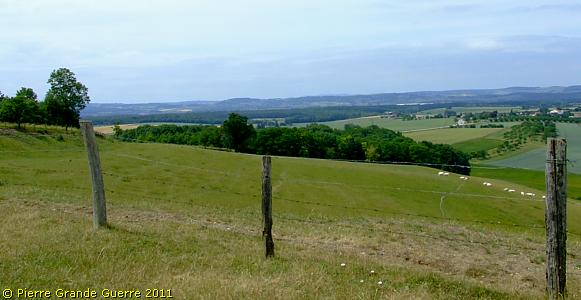
Anthelupt.
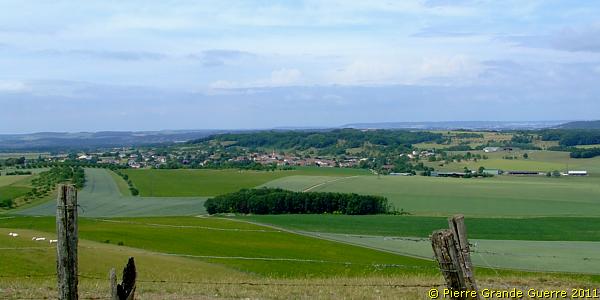
Panorama view north-eastward, left Nancy.

During the last phase of the Battle of Lorraine Nancy formed the main target for Crown Prince Rupprecht von Bayern's 6. Armee.
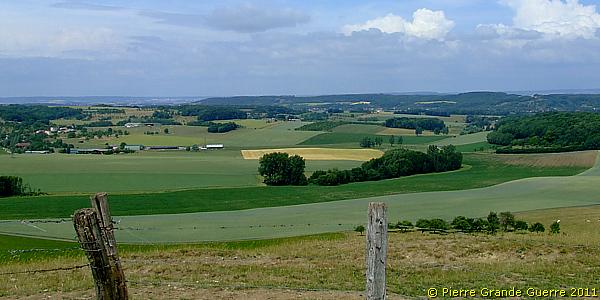
A teleview to show you how close the Bavarians came to Nancy.
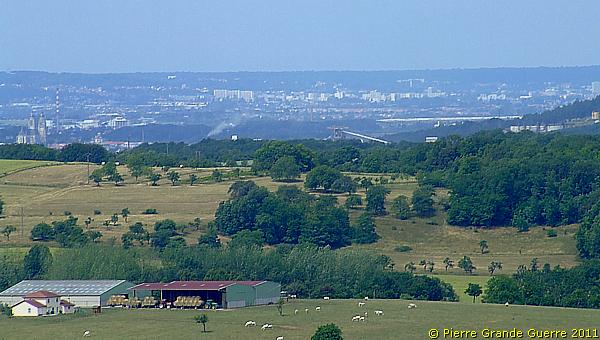
A view of the landscape more north-eastward.
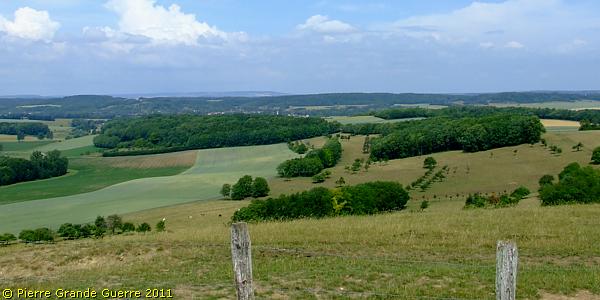
This hill is one of the locations, which formed together the Trouée de Charmes , or the Gap of Charmes.
The Gap of Charmes

The “Trouée de Charmes”, or the Gap of Charmes, formed literally a gap in the French defensive lines north-east of the town of Charmes. As you can see on the map above, there were many fortresses around Toul and Epinal in the Vosges. But around Lunéville, in the rather open landscape of plains and hills, there was only one fortress, the Fort de Manonviller.
In this open country there are three natural obstacles, being the rivers Moselle, Vezouze and Meurthe. These last two rivers link together directly west of the city of Lunéville.
Any German Army which could break through the Gap of Charmes, would have been awarded with the advantage of three options to facilitate the continuation of its campaign on more accessible terrain: 1. Go right and attack Nancy and Toul, or 2. Go left, and attack St. Dié and Epinal, or 3. Advance directly to the Champagne.
Another reason why this weak link in the French defensive line was called the Gap, was the fact that the French 2nd Army linked up here with the 1st Army. During the period of 20 -23 August the flanks of these armies almost lost contact. During the Battle of the Trouée des Charmes from 24 until 26 August 1914, it took the French 2nd Army much effort to withstand the German attacks. It even needed the assistance of the 8e Corps d’Armée of Dubail’s 1st Army.
The Battle of Lorraine was fought during a period of mobile warfare with almost daily moving front lines.
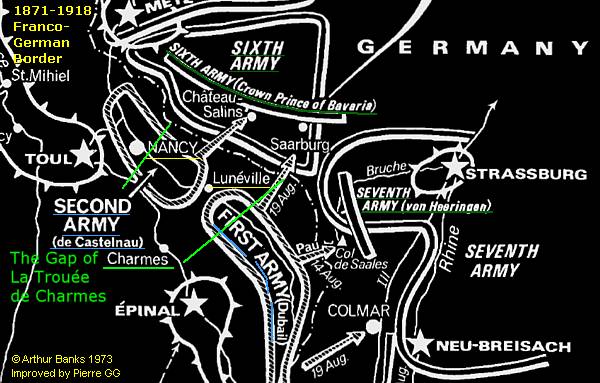
Broquet's statue does not show us, alas, the colourful 1914 outfit of the French officers and soldiers.
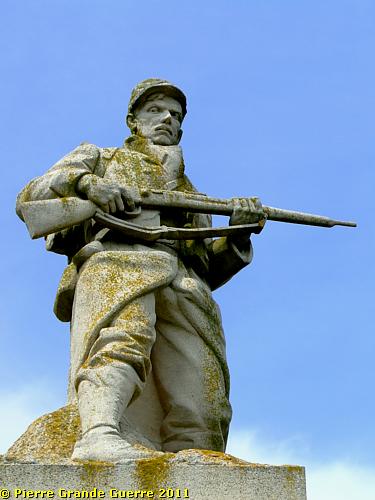
This Poilu wears a field cover over his red cap. Light infantry men, Chasseurs à Pied, wear dark blue trousers and a dark blue cap.
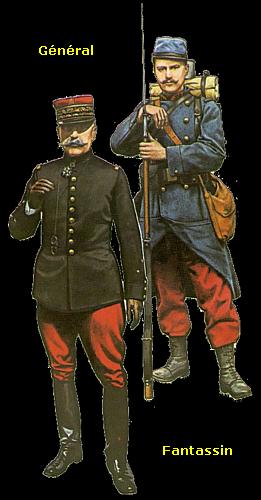
Before we go on: To understand better this location and the other locations we will visit during this trip, I explain in the frame below some concise background information about the complex situation of the several 1914 battles in the area of the Trouée de Charmes.
The Battles of the Frontiers - The Battle of Lorraine - 14 August - 13 September 1914
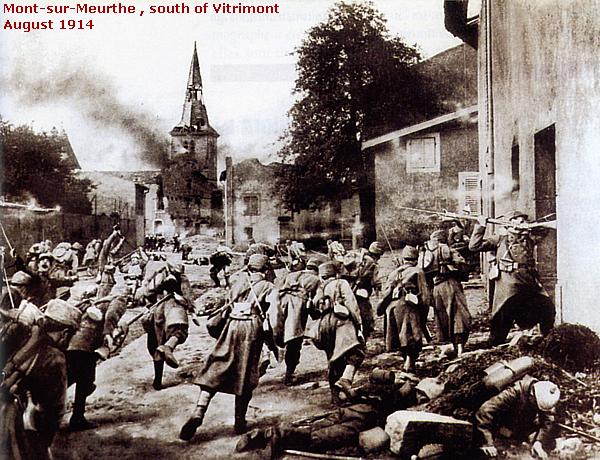
The Battle of the Léomont was only one of the battles fought during the
period of 14 August until 13 September in this region of the Gap of
Charmes.
During the period of mobile warfare of the Battles of the Frontiers the
German Armies advanced in Belgium according to the Schlieffen Plan to
Brussels, Namur and Mons. In Alsace-Lorraine Joffre deployed three Armies to
execute his Plan XVII, or Plan 17, to win back the territories France
had lost to Germany in the Franco-Prussian War of 1870-1871.
Though the Alsace Army was at first rather successful in the Alsace Sundgau, the fighting in Alsace Lorraine and the Northern Vosges did not develop at all according to the French plans for the 1st Army and 2nd Army.
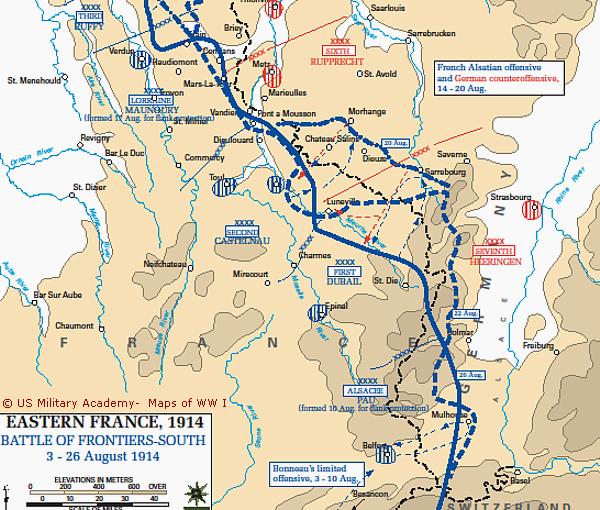
The Battle of Lorraine - 14 August – 13 September 1914
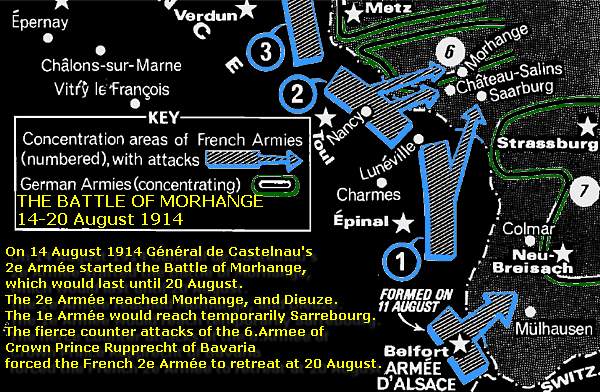
The French historians call this period of 14 August – 13 September 1914 in Lorraine the Battle of Lorraine. It was in fact a sequence of several battles in almost the same area during 4 weeks; the Battle of Morhange , the Battle of the Trouée de Charmes , including the Battle of Rozelieures , the Battle of the Mortagne , and the Battle of the Grand Couronné , east of Nancy. The Battle of Rozelieures resulted also in the fi rst French victory of the Great War.
South of the Trouée de Charmes the French 1e Armée of Général Dubail fought during these battles in the Alsace Vosges and Général Bonneau’s Army of Alsace in the Alsace Sundgau (later Général Pau) against the 7. Armee of General von Heeringen. In the Vosges the 1e Armée would fight another battle, the Battle of the Haute-Meurthe , which lasted from 24 August – 11 September.
The Opponents in Lorraine

In Lorraine the units of Général de Castelnau’s 2e Armée fought against the units of the Bavarian 6. Armee, commanded by Kronprinz Rupprecht von Bayern, Crown Prince Rupert of Bavaria.

The Bavarian opponents were less colourfully dressed than their French enemies, and used a more natural colour.

14–20 August 1914 - The Battle of Morhange
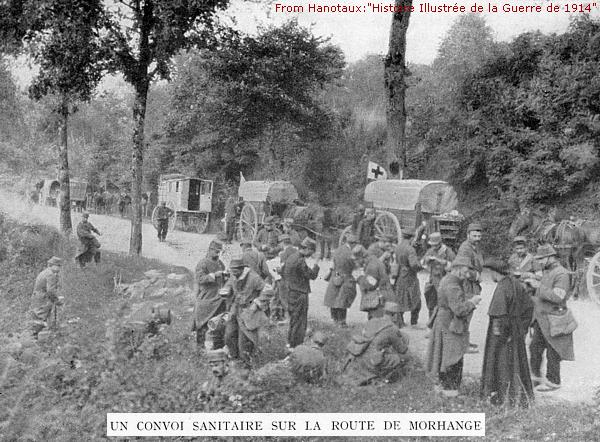
The troubles in the Trouée de Charmes started on 14 August 1914 with the French attacks on German territory, annexed from France in 1871.
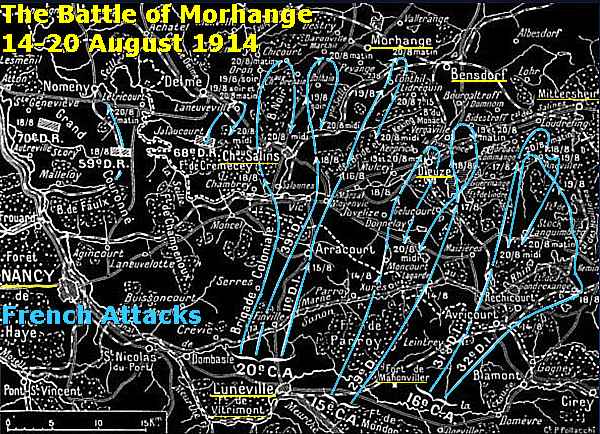
From the south the 1st Army attacked Saarburg. From Toul and Nancy Général de Castelnau’s 2nd Army attacked and reached Château-Salins, Morhange, and Dieuze.
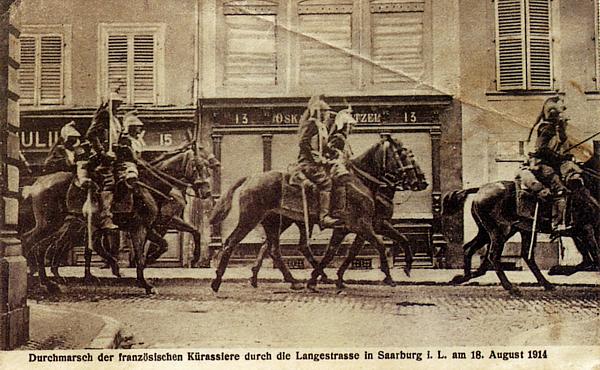
Crown Prince Rupert's mission was to engage the French forces and to keep these fixed in the centre, giving room to the advance of the right wing of the German Army, which as part of the Schlieffen Plan, encircled his opponents in the north-west.
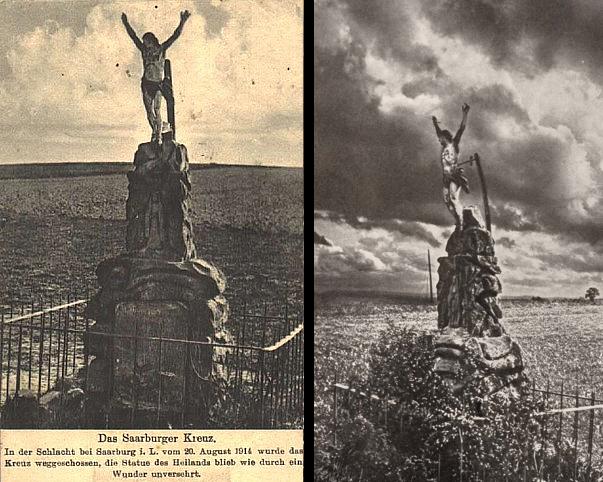
During these days the French and Germans deployed each some 150,000 men on
the Lorraine battlefields.
The Bavarian troops proved to be better marksmen than the French, inflicting
heavy casualties on the French infantry.
From the beginning of the war the town of Morhange was defended by hills,
fortified by light military works and artillery batteries and it acquired the
nickname "Wall of Morhange." The French armies were stopped at the
foot of these hills. They could not break the German resistance and were
forced to retreat. For more details, visit later my web chapter about
T
he Battle of Morhange - 1914
.
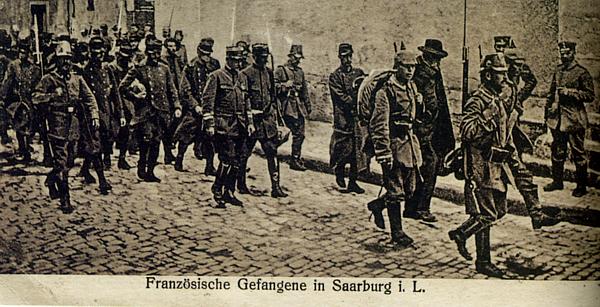
20-23 August 1914 - The French Retreat - " Die Schlacht in Lothringen"
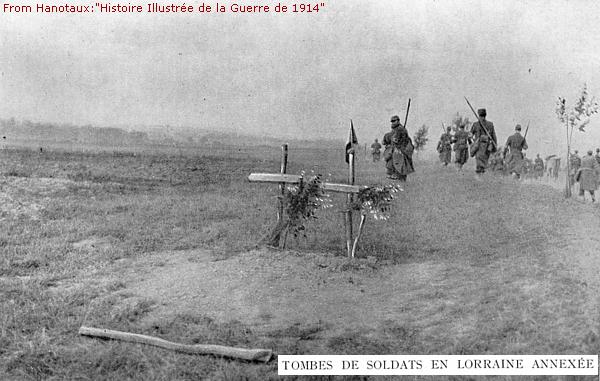
After six days, on the 20th, the counter attacks of Prince Rupert’s units forced the 2nd Army to withdraw. Three days later also Dubail’s 1st Army in the Vosges was forced to withdraw under pressure from von Heeringen’s 7th Army.
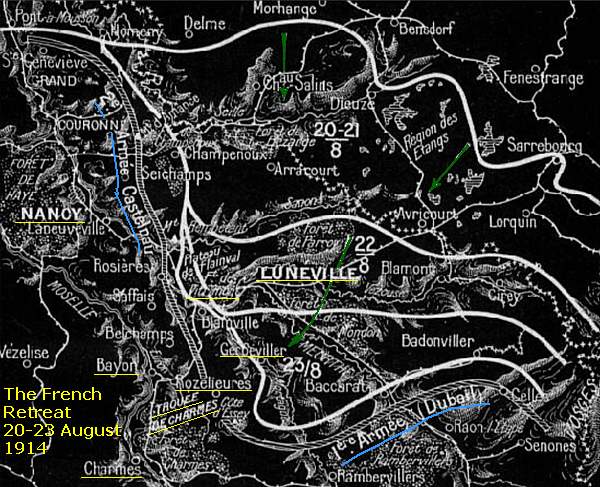
The Bavarians counterattacked and recaptured Château-Salins, Morhange and Dieuze.
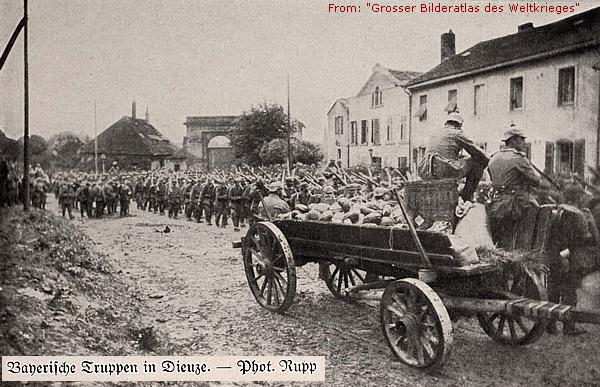
On 20 August, Crown Prince Rupprecht’s Bavarians started to hunt the French in their fighting retreat to the Franco-German Border. On 22 August the Bavarians captured Lunéville. The Battle of Morhange ended with a German victory.
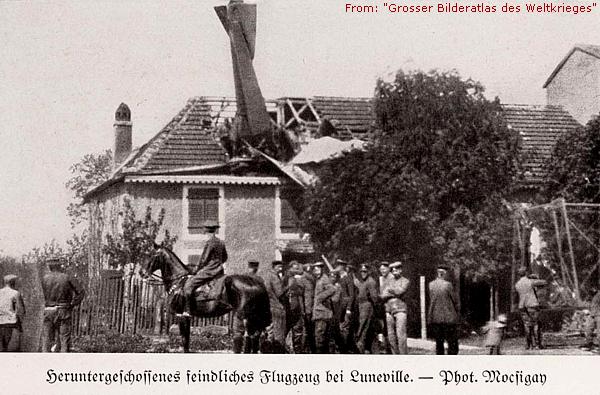
24 -26 August 1914 - The Battle of the Trouée de Charmes
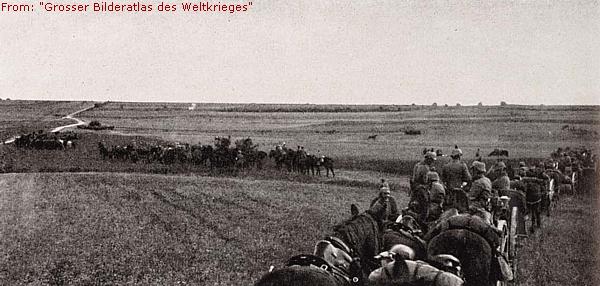
Rupprecht’s Bavarians did not stop at the Franco-German border but immediately advanced south through the Gap of Charmes. On 24 August units of the 21. Armeekorps reached Gerbévillers, Remenoville and Rozelieures.
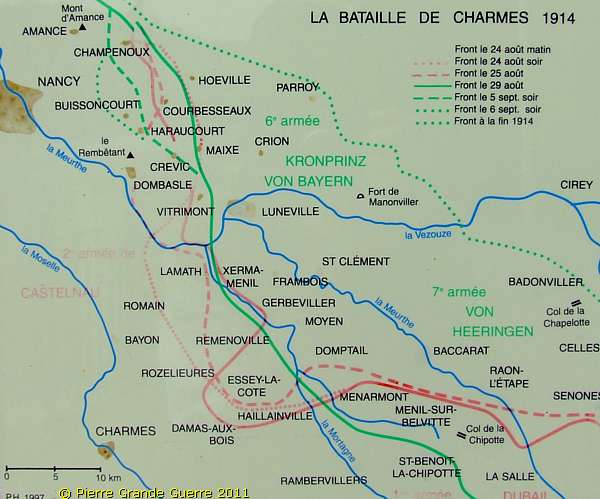
The 8e Corps d’Armée was temporarily separated from Dubail’s 1e Armée and attached to the 2e Armée to serve as its right flank. General de Castelnau’s units counterattacked in a pincer movement from the east and west the flanks of the 21. Armeekorps. At Clayeures and Romain, north of Bayon , the units of the 74e D.I. stopped the Bavarian advance.

At St. Boingt the 8e Corps d’Armée repelled the attack of the Bavarian 1. Armeekorps. Général Fayolle’s 70e D.I. attacked the units of the Bavarian 2. and 3. Armeekorps with success near the villages of Erbéviller, Réméréville and Courbesseaux. In all these villages in this area there was fierce hand-to-hand fighting in the streets. That day the French succeeded partly in halting the Bavarian advance.

The Battle of Rozelieures - France's First Victory
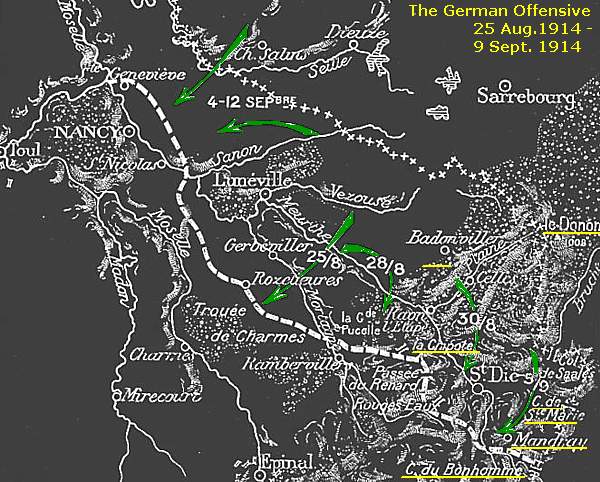
On 25 August the Battle came to a head at Gerbéviller and Rozelieures.
During the night de Castelnau ordered almost all artillery fire to
concentrate on the centre of the battle zone near the village of Rozelieures.
Fighting from the early morning on and after a fierce battle of 9 hours
the 2e Bataillon des Chasseurs à Pied of the 6e Groupe de Chasseurs Cyclistes
(light infantry
on bicycles) and a half squadron of the 1e Régiment des
Hussards
(light
cavalry) succeeded in forcing the units of the 21
Armeekorps to retreat from the village northward.
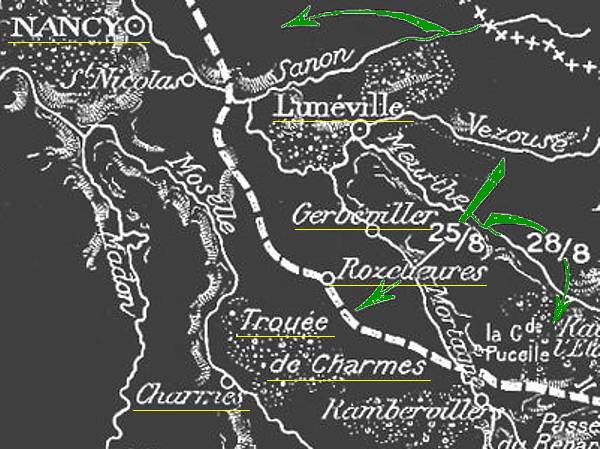
According to French sources the Bavarians counted on the 25th at least 2,500 men killed and 6,000 other casualties. The Battle of the Trouée de Charmes ended as a French victory.
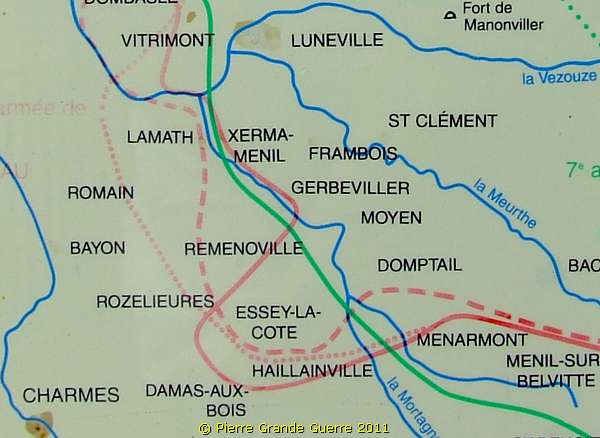
More details about the Battle of Rozelieures are to be found later on this page.

26-29 August 1914 - The Battle of the Mortagne
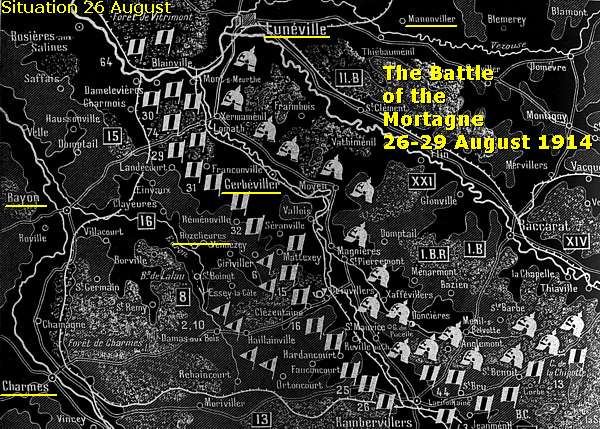
The next day, on the 26th, the Bavarians retreated over the Meurthe and
the Mortagne.
On the location, where we stand now, on the Léomont near Vitrimont and
Lunéville, the French Iron Division, the 11e D.I., and especially the unit of
the 26e R.I., celebrated that day their own victory over the units of
the Bavarian 2. Armeekorps. The 26e R.I. captured the Léomont and other units
of the 11e D.I. captured that day also the nearby height of Friscati, and the
villages of Deuxville, Maixe, and Drouville.
The Capture of Fort de Manonviller
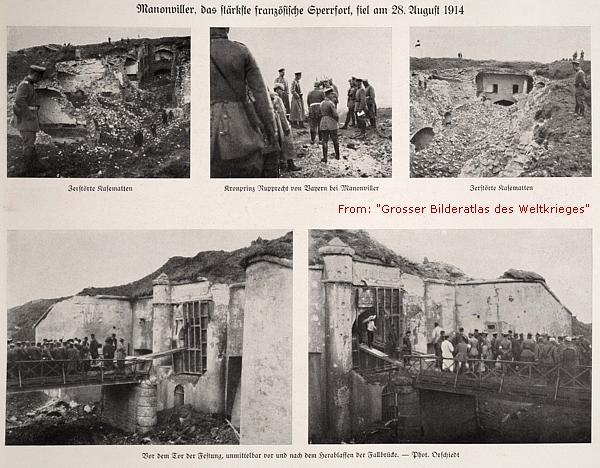
On 27 August after a continuous artillery bombardment with large calibre shells for two days the Bavarians captured the Fort de Manonviller - by then already totally destroyed. This capture formed for the Germans a most important event. The Crown Prince came to inspect himself the ruins of the fortress.
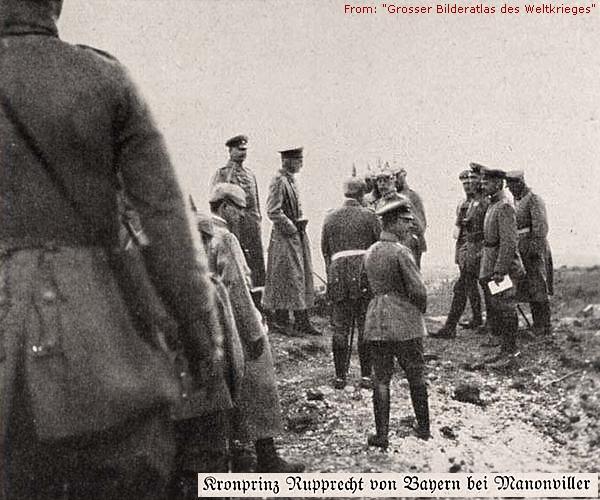
29 August - 3 September 1914: A short period of rest and reorganization

With his troops decimated at Morhange and Rozelieures and with a gap to secure for eventual next attacks, de Castelnau decided not to deploy a counter-offensive but to reinforce the lines around Nancy and the lines of the Trouée. Rupprecht von Bayern’s troops counted also heavy losses, especially on the flanks, and he decided to withdraw his Army for a short period of rest and for reorganization.
4–13 September - The Battle of the Grand Couronné
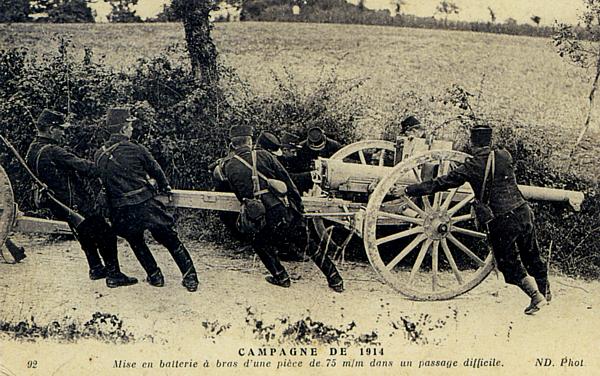
During the period 4 - 13 September the north-western area of the
Gap, around Lunéville and Vitrimont, was again involved in another
battle; the Battle of the Grand Couronné.
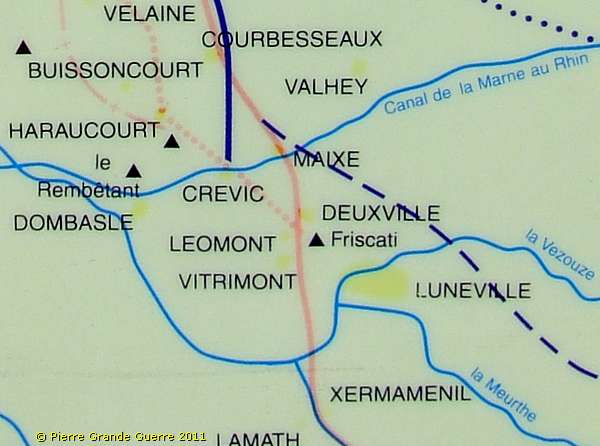
The Grand Couronné formed a defensive line on a series of heights, east of Nancy, including the heights of the Léomont and Friscati.
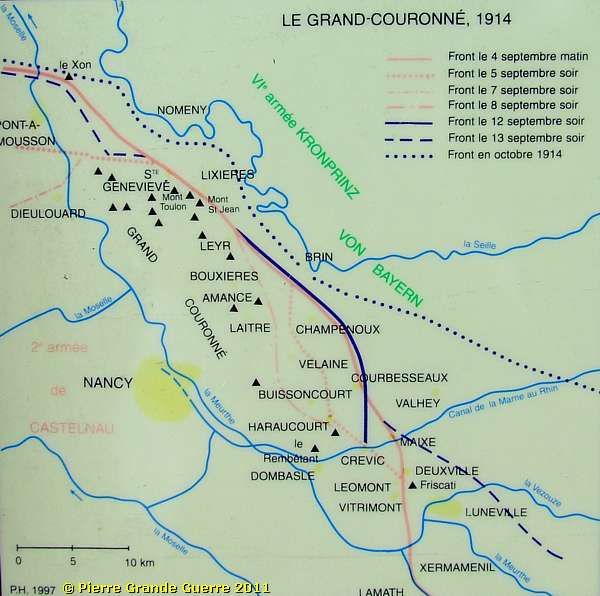
On the heights of the Grand Couronné, east of Nancy, De Castelnau placed the 20th Army Corps of Ferdinand Foch to defend the city.
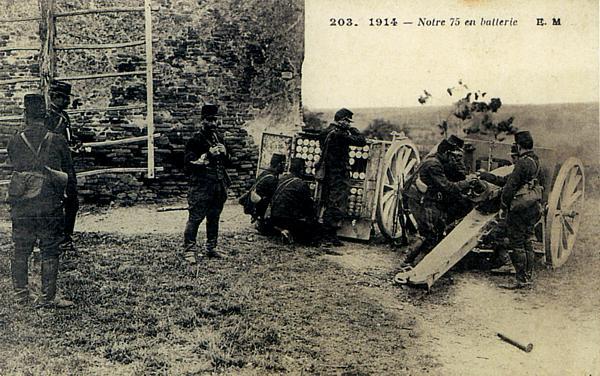
On 4 September Crown Prince Rupprecht launched a new offensive to conquer
Nancy. Rupprecht deployed some 350,000 men, while de Castelnau waited with
some 225,000 men.
On the same day in the west the French Army was preparing for a more famous
battle, which would start the next day: the
Battle of
the Marne
.
During the battle all villages in the region were destroyed. On 9 and 10
September Nancy suffered an artillery bombardment of two days.
The German Withdrawal
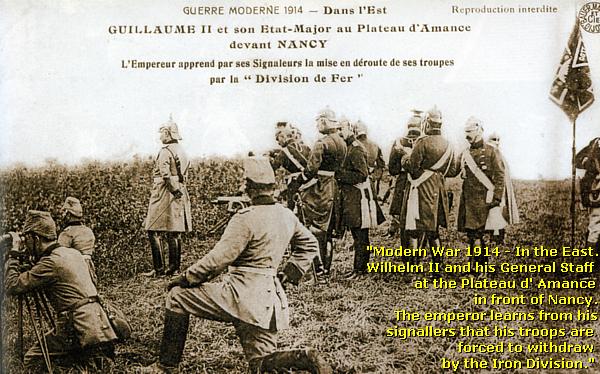
In the Vosges von Heeringen’s
Haute-Meurthe
Offensive
did not reach its goal, the capture of St. Dié.
From 10 September von Heeringen retreated from the
Col de la
Chapelotte
on Saales.
For the 6th Army the Battle for the Grand Couronné was also not successful at
all. Under pressure of General's Foch's 20th Army Corps Rupprecht was not
able to capture Nancy.
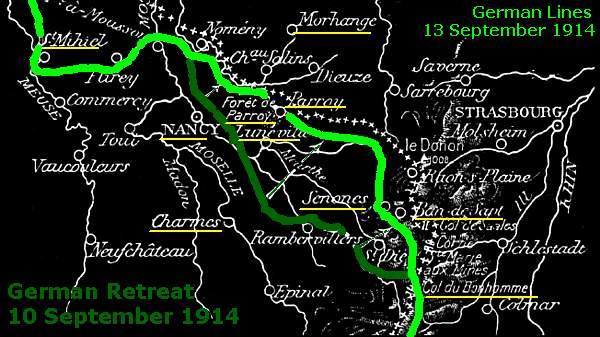
On 11 September the Oberste Heeres Leitung decided to withdraw Rupprecht’s 6th Army under cover of artillery fire. The Bavarians left Lunéville and retreated from Nancy to the Franco-German border of 1871-1918. At some places they even retreated to locations in front of this border, on French territory. After the German retreat the new frontline of Lorraine consolidated until 1918.
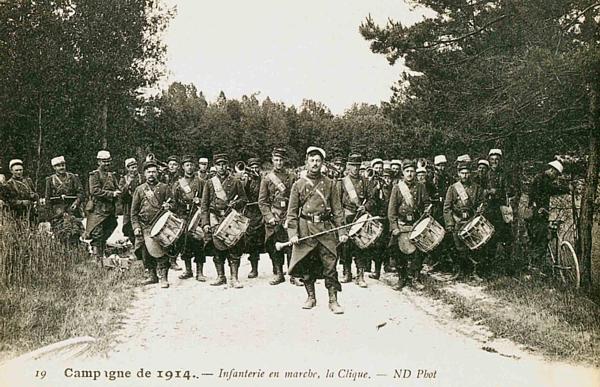
On 13 September the 2e Armée recaptured Lunéville, left by the retreating
Germans, without firing a single shot.
The Battle of the Grand Couronné ended with a French victory. (For more details visit later my web chapter about the Battle of the Grand Couronné
.)
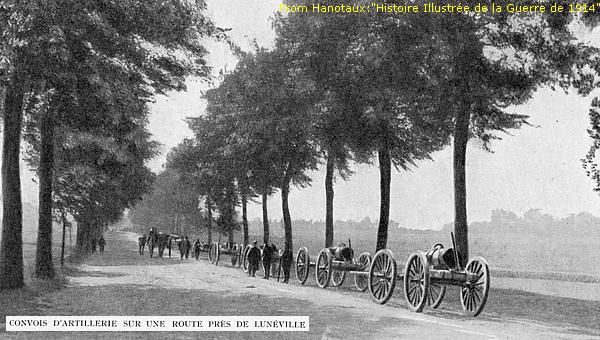
The Aftermath
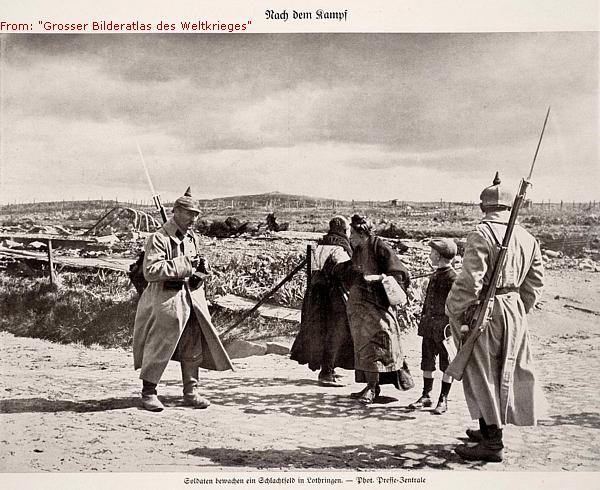
In France the Battle of the Trouée de Charmes is not only considered a great victory, but in combination with the Battle of the Meurthe-Mortagne all these consecutive Battles of Lorraine are also considered to be of great importance, having a decisive influence on the outcome of the other more famous battle: the German defeat in the Battle of the Marne .
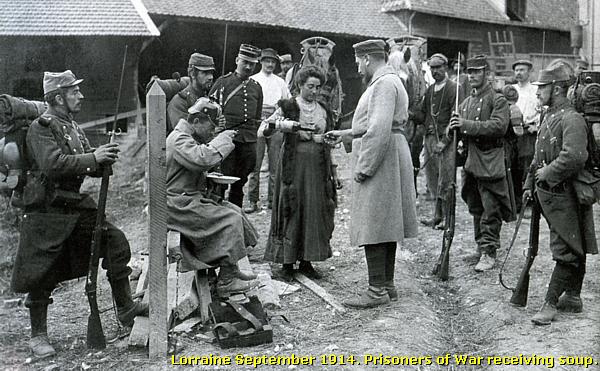
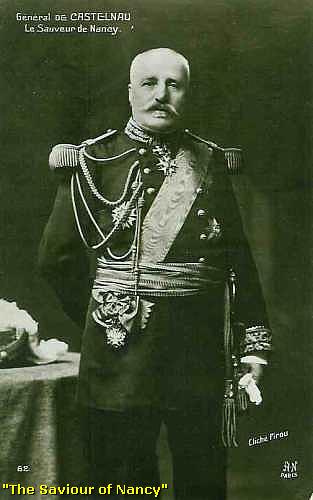
After this intermezzo we return to 2011 and to the view of the statue of the Léomont.

From now we follow the view of the eyes of Broquet's soldier .

We continue with some clockwise panorama views over the Léomont battlefield northward and eastward. Perhaps now you will be able to recognize some names of the locations, mentioned in the frame above.

View slightly north-west and north.
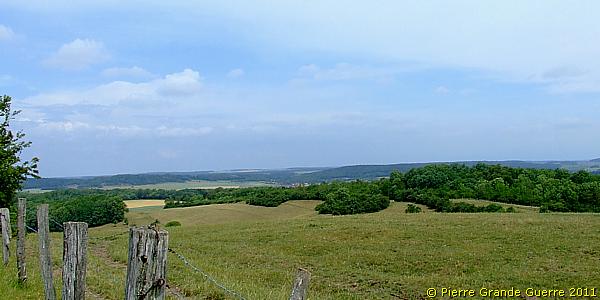
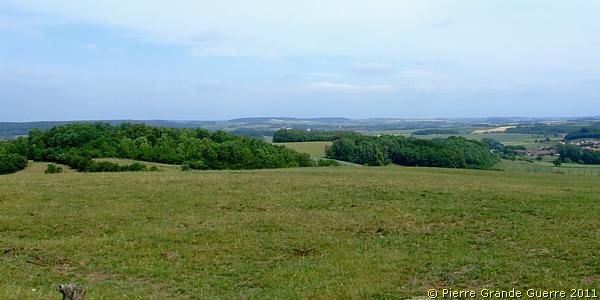
View northward at the village of Deuxville.
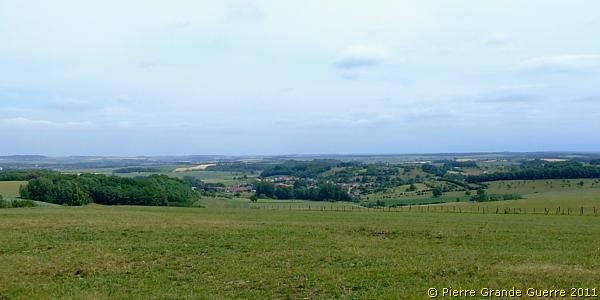
Teleview of Deuxville.

We continue and turn north-east and eastward.
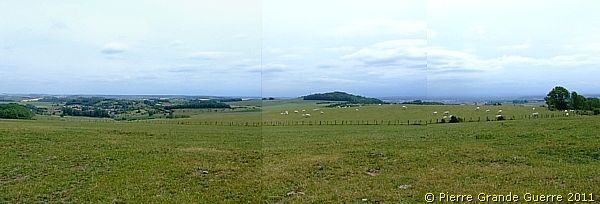
View into the direction of a location, called la Tombe, which we will later visit and the Hill of Friscati.
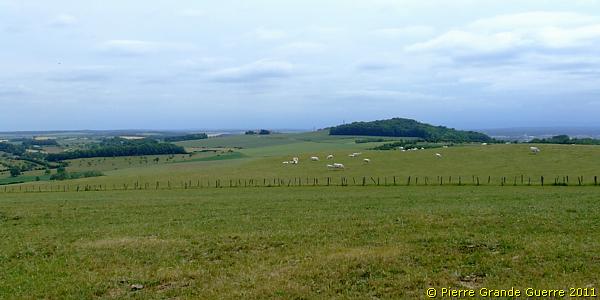
View eastward to the valley, where Lunéville is.
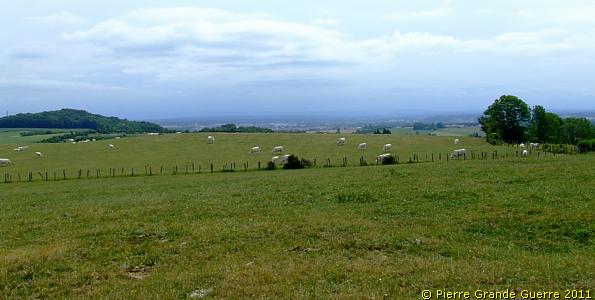
A teleview from the Léomont to Lunéville.
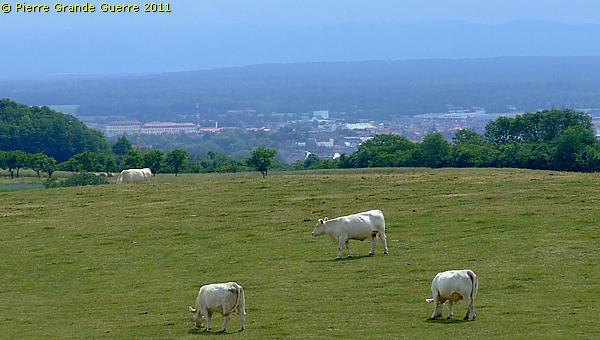
We leave the Léomont, ...
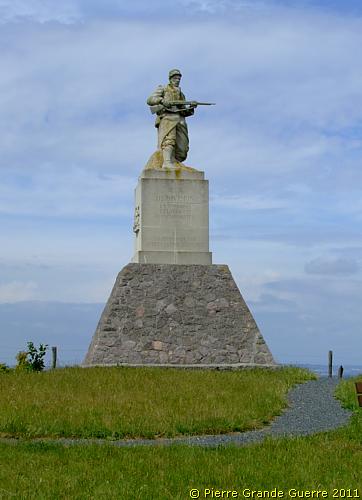
... and we continue some 1.5 km. eastward to the hill of Friscati.

In the valley along the D 400 we detect this memorial, ...
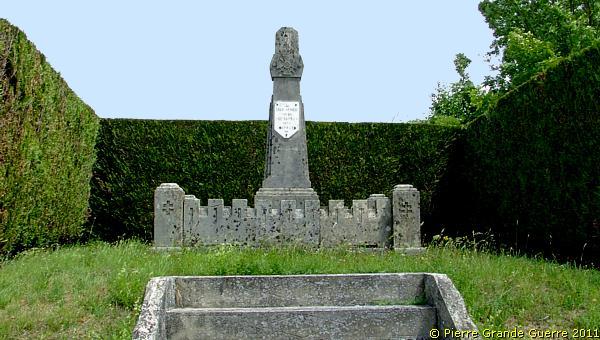
... commemorating three units, which were active in this area.
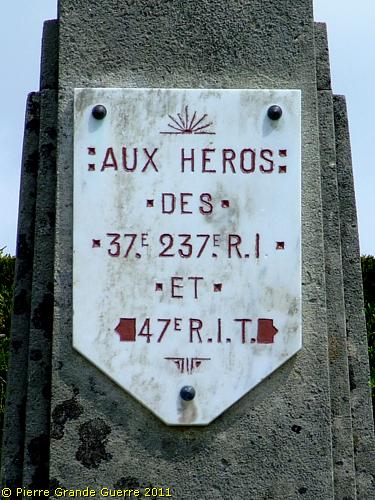
At this memorial we leave the D 400, we go left, and we follow the D 97 up the hill. At the cemetery building near the junction we park our car.

We will first visit a small chapel, opposite the cemetery.
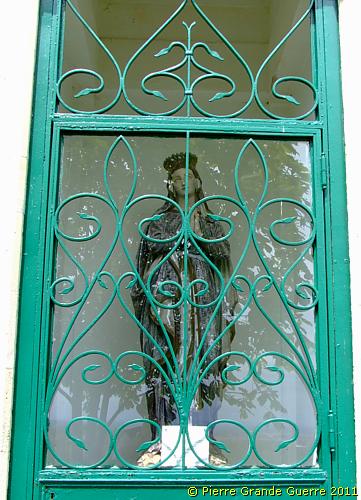
View eastward from the chapel to Lunéville.
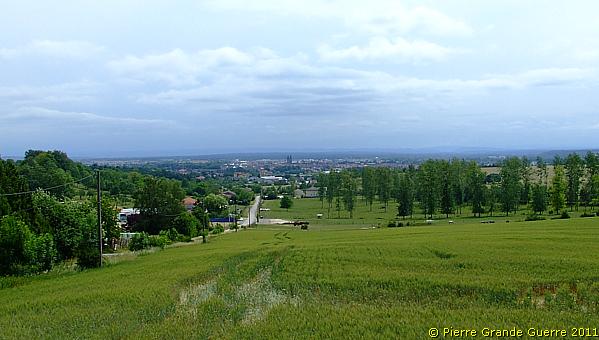
We cross the D 97 and we enter the Vitrimont - Friscati Nécropole Nationale .
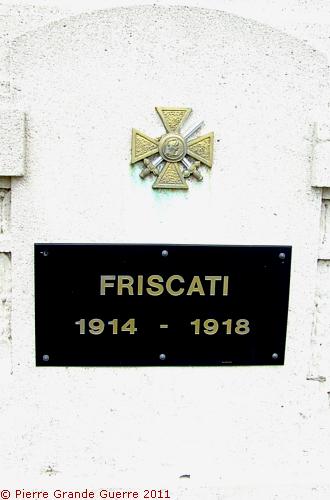
|
The Nécropole Nationale of Vitrimont–Friscati contains the human remains of 3,751 men. There are 2,068 individual graves and three communal graves, together containing the human remains of 1,683 men. The officers and soldiers, buried here, were killed during all periods of the war, but the large majority of them fell in the area around the cemetery during the period of August-September 1914. You will find also graves of men of colonial units, and a special memorial commemorating the troops from Morocco. As we enter the cemetery, we are immediately confronted with ... |

...this Arch of Triumph, covering a colourful Poilu statue in a 1915-1918 outfit.
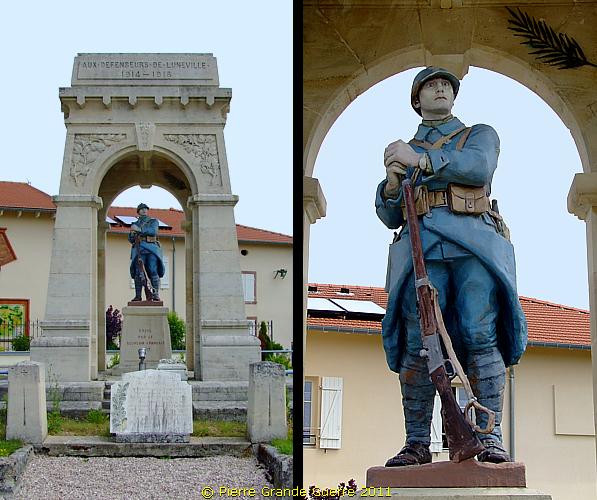
This Poilu, guarding his 1914 comrades in arms, is equipped with the " Bleu Horizon " battle dress and the " Casque Adrian ", the Adrian M 1915 helmet. From February 1915 this light blue outfit, meant as camouflage, was distributed gradually to the French troops.
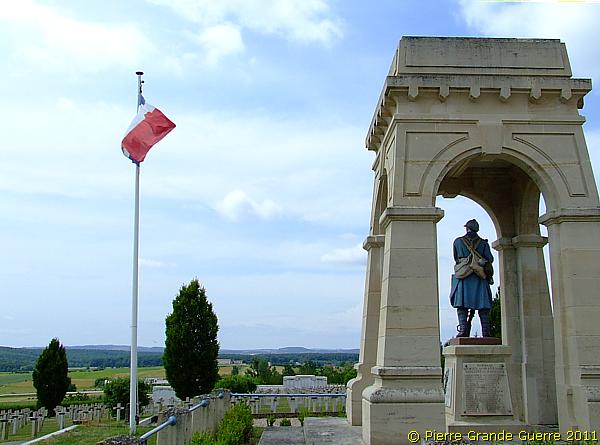
From the arch we descend the slope of the cemetery
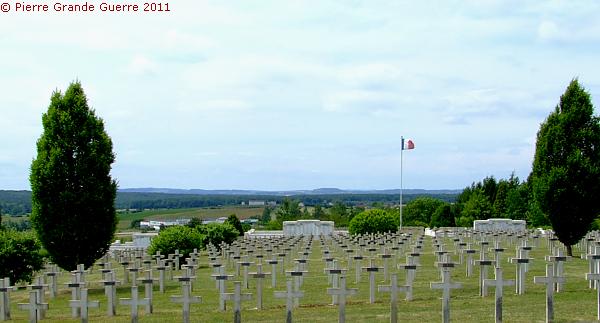
The three large communal graves, from right to left: Ossuary Number 1, ...
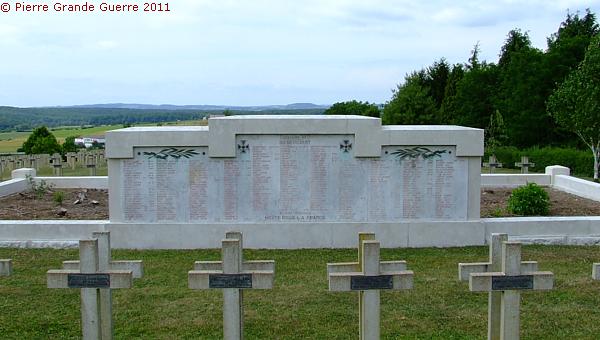
... Ossuary Number 2, ...
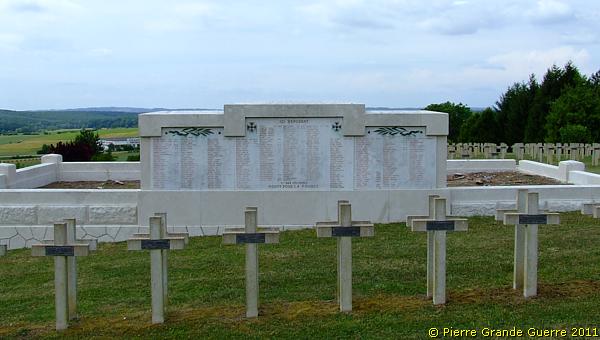
... Ossuary Number 3.
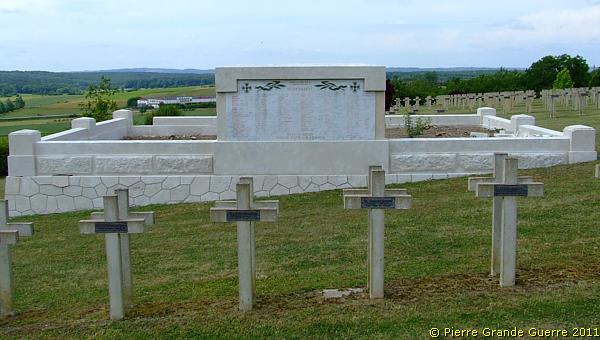
The majority of the human remains, buried in these communal graves, belong to unknown soldiers.
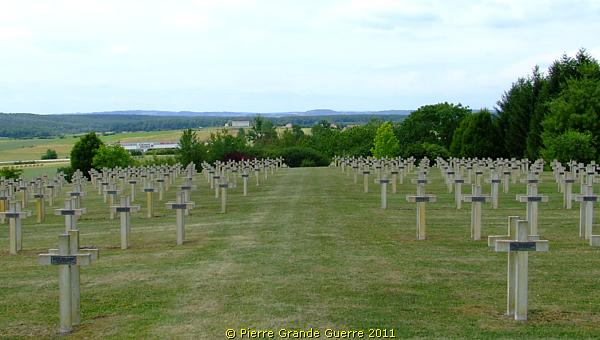
The grave of a member of the 71e Bataillon Chasseurs à Pied.
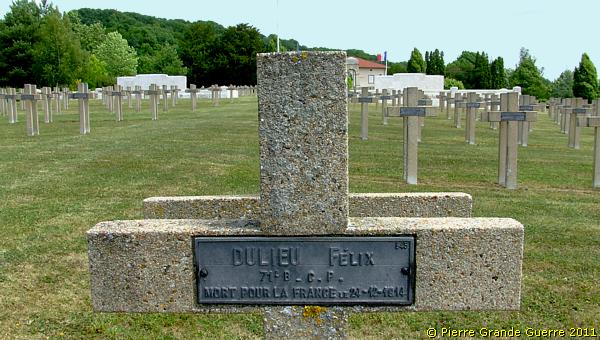
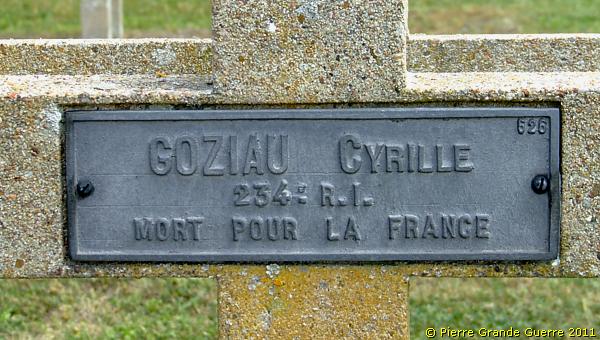
The grave of Zouave soldier of the 1e Régiment des Zouaves.
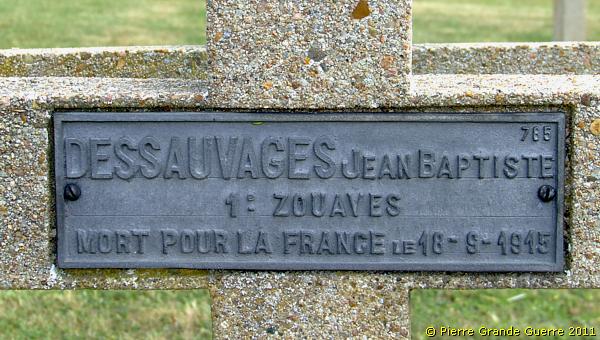
Zouaves
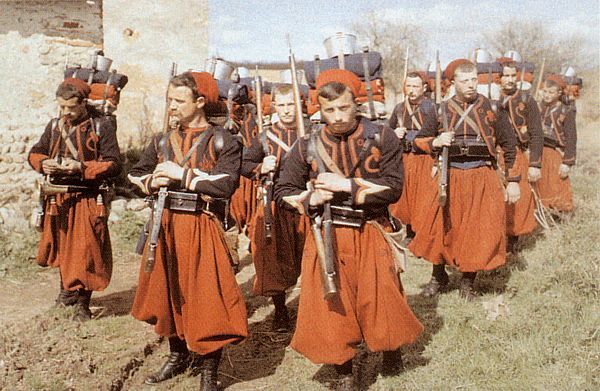
Originally, in 1831, the Zouaves were founded and based in Algeria. In 1914 the Zouaves regiments were developed as a mix of Algerian soldiers and a majority of French soldiers. To demonstrate the colourful outfit of these Zouaves, I show you here an original colour period photo of 1914-1915, a so called "Autochrome", of a unit of the 3e Régiment des Zouaves.
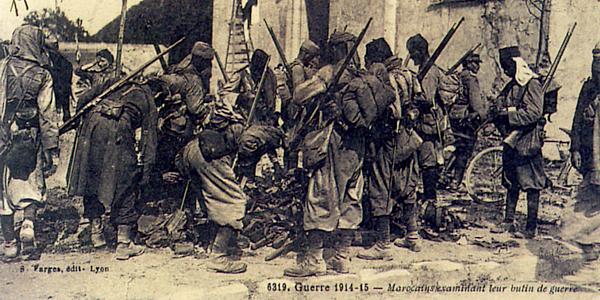
The grave of a Jewish Zouave soldier is sharing the same plot of the graves of his Muslim brothers in arms, fallen in 1917.
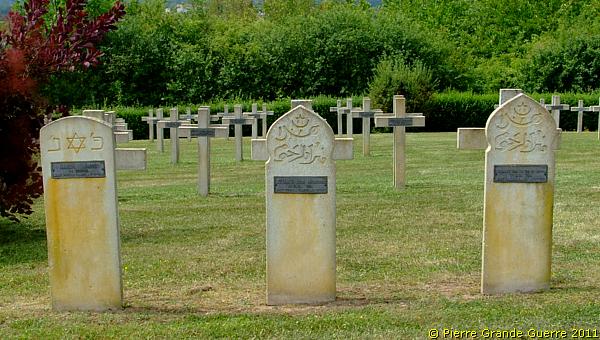
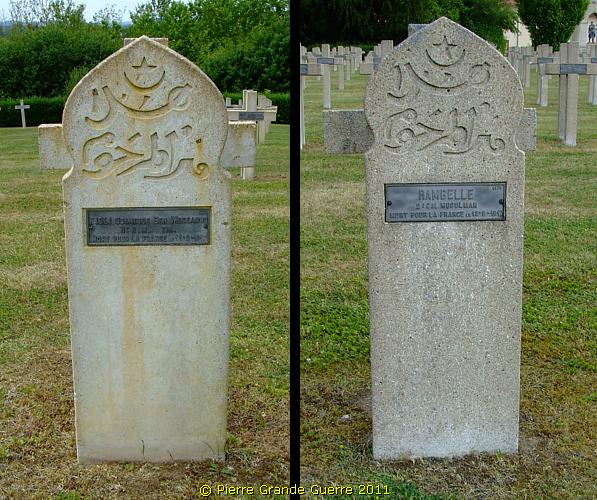
Left: The grave of a Tirailleur of the 3e Régiment Marocain des Tirailleurs. (Sharp shooters / Riflemen)
- Right: The grave of a cavalryman of the 2e Régiment de Cavalerie Musulman (Second Muslim Cavalry Regiment)
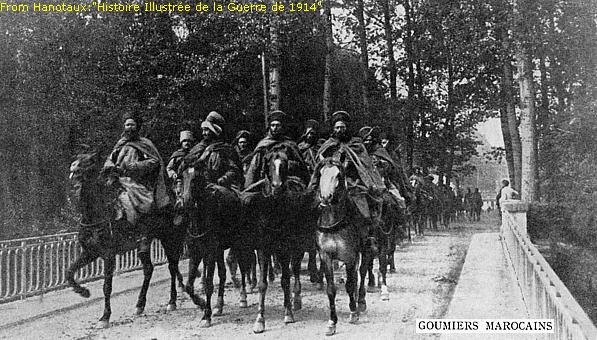
The grave of a soldier of a light cavalry unit, ...
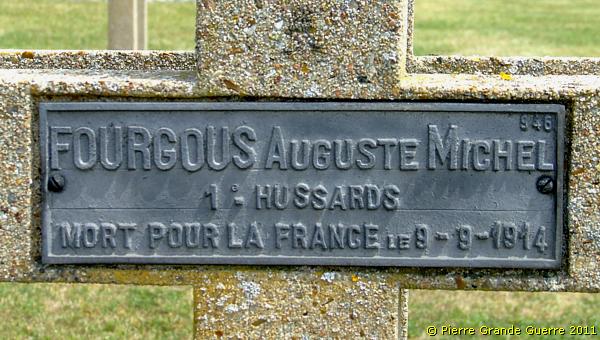
.... the 1e Régiment des Hussards, fallen in September 1914.
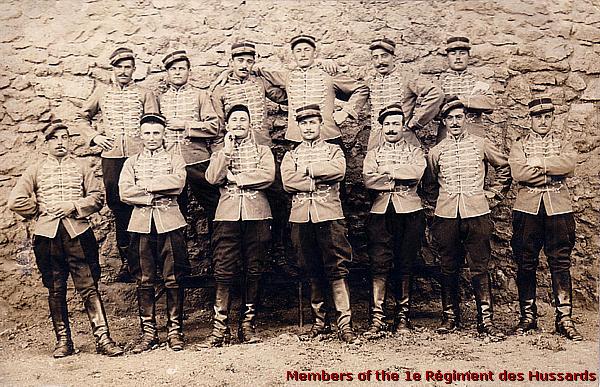
The grave of a member with a German sounding name of the unit, the 26e R.I., which captured the Léomont.
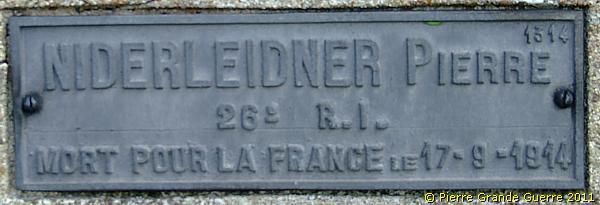
We ascend the hill for a last view of an interesting memorial, ...
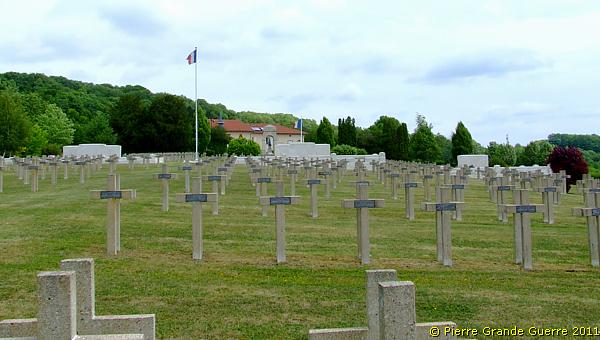
... dedicated to the Moroccan troops, ...

... on the initiative of their former commander, Maréchal Lyautey, who was born in Nancy.
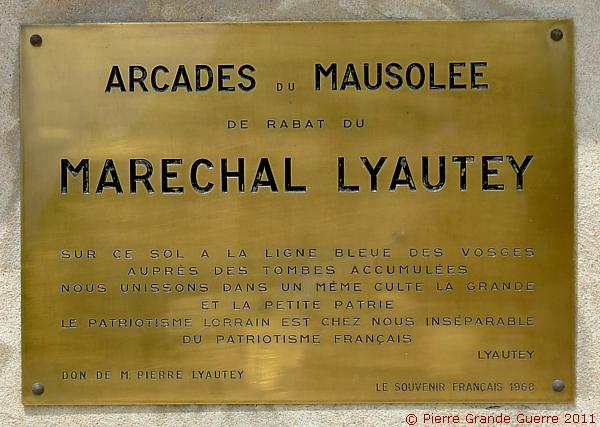
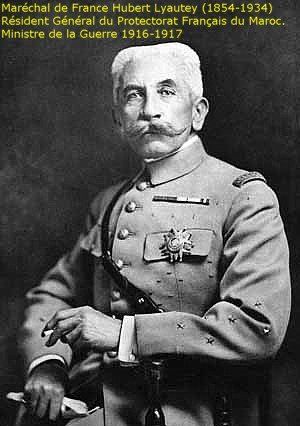
We leave the cemetery.

From the road before the cemetery a teleview eastward at Lunéville.
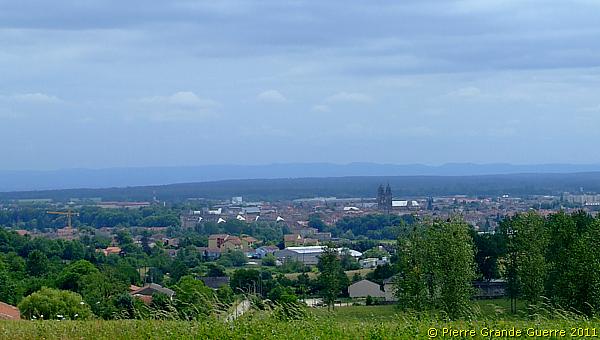
We continue northward to a location, called la Tombe.
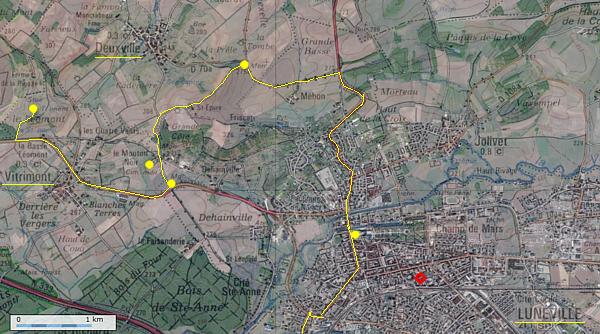
On our way to la Tombe we find in the verge of the road this individual memorial:
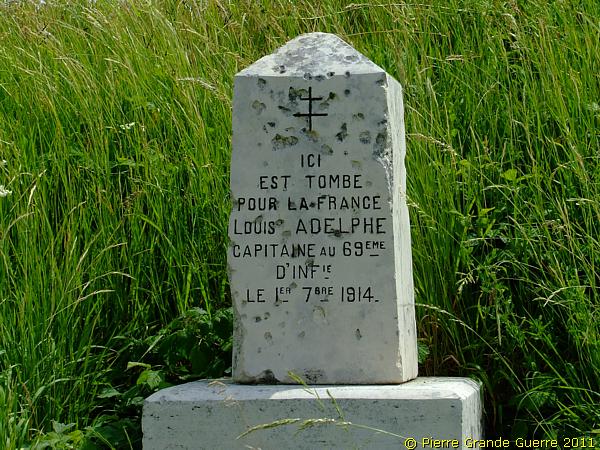
Outside the village of Deuxville we arrive at a junction at a location with the ominous name la Tombe ( the Grave ).
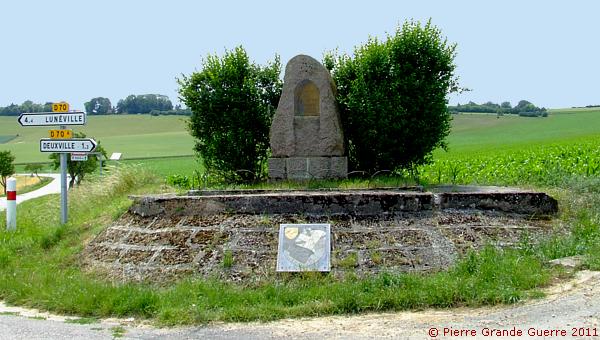
A memorial reminds us of some of the units, who fought in these fields of la Tombe.
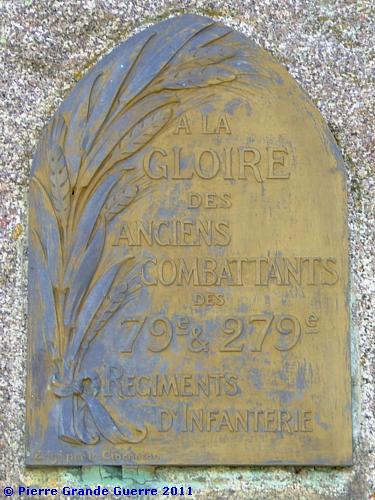
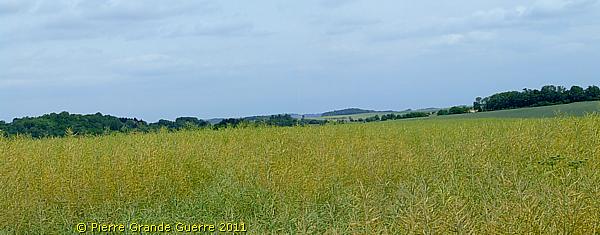
From the la Tombe Memorial I made some panorama shots of the battlefield northward in 4 overlapping panorama views, clockwise from west to east. The first panorama north-westward is above, the next three will follow below.
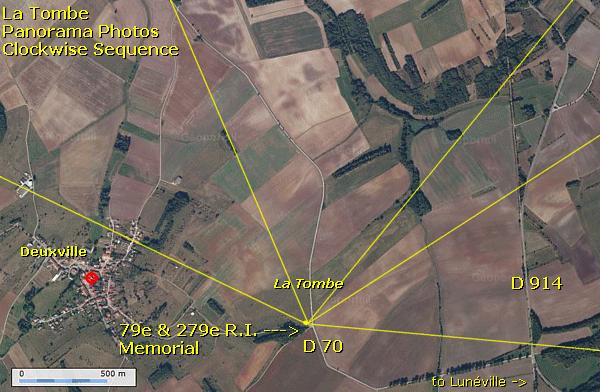
View northward.
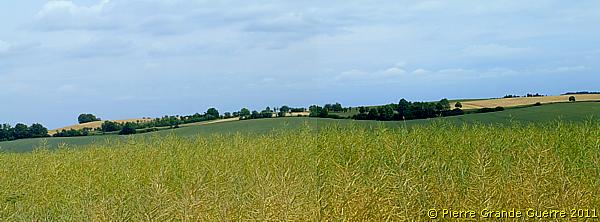
View north-eastward.

View eastward.
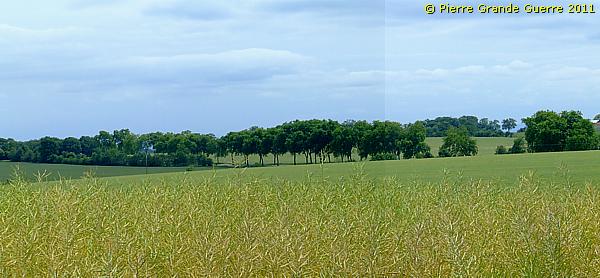
A normal view slightly more eastward.

We leave the la Tombe battlefield and we continue via the D 70 ...
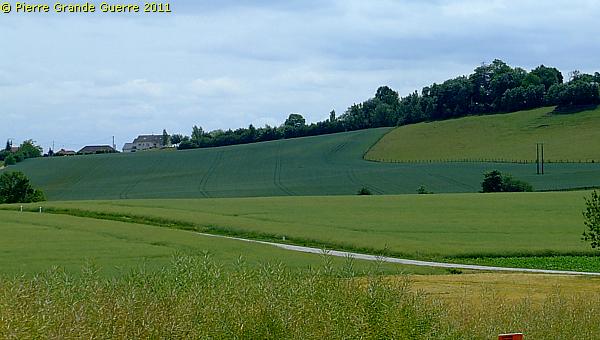
... southward for a short visit to the city of Lunéville .

After crossing the Vezouze we visit in the centre of Lunéville its impressive Château de Lunéville.
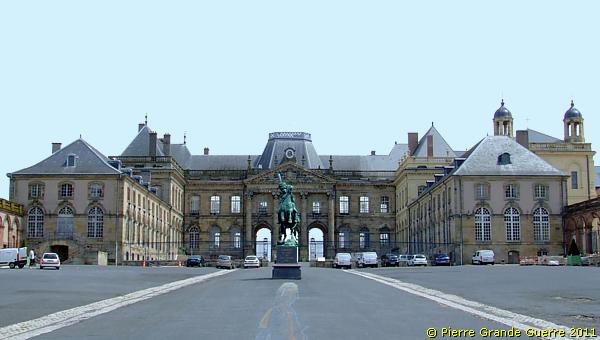
Lunéville; "City of the Cavalry"
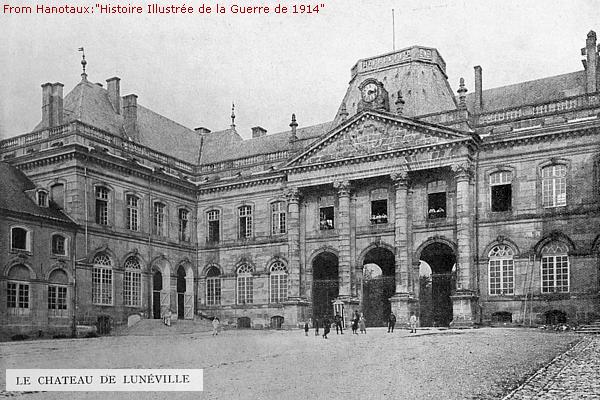
On the eve of the Great War, Lunéville became the "City of the Cavalry", being the garrison city of the 2nd Cavalry Division and its units, amongst others: the 17e et 18e Régiments de Chasseurs à Cheval, the 3e Bataillon de Dragons Portés (Dragoons) , the 8e et 31e Régiments de Dragons, the horse batteries of the 8e et 39e Régiments d'Artillerie de Campagne (Field Artillery) . To house these units Lunéville counted at least 8 barracks, including its Château.
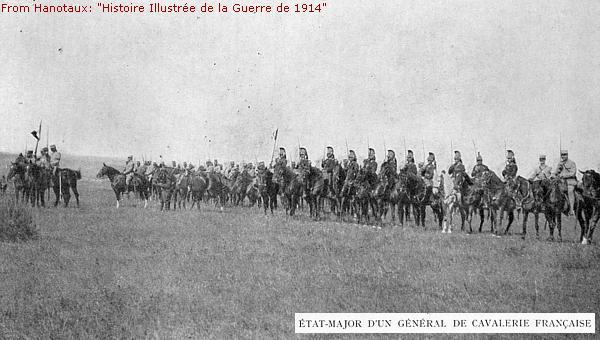
The 2e Bataillon de Chasseurs à Pied
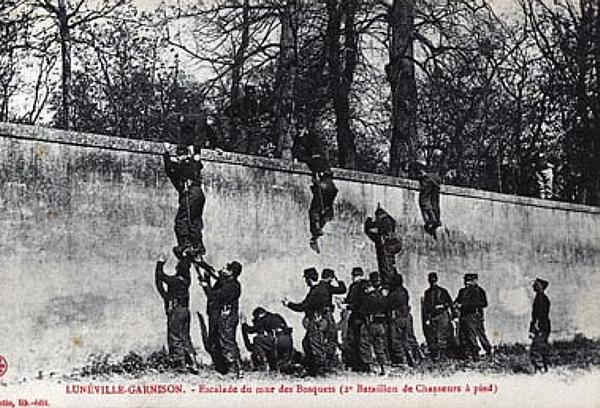
The infantry unit of the
2e Bataillon de Chasseurs à Pied
,
a component of the 11e D.I., had its barracks also in Lunéville. This unit
played a decisive role in the combats in Rozelieures, Remenoville and
Gerbéviller.
In front of the Château stands this equestrian statue, which has no relation to the Great War at all. But I thought it to be too beautiful to leave it out. The statue represents Général Lasalle.
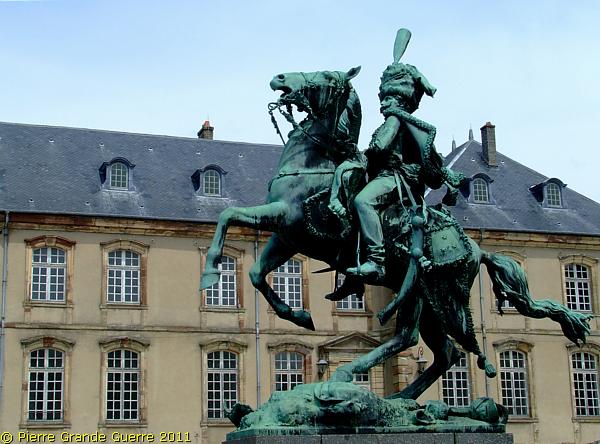
Comte de Lasalle
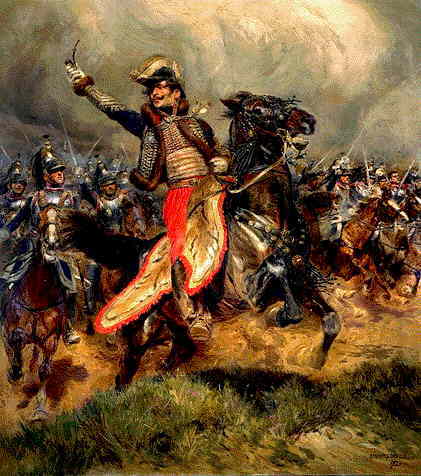
Antoine Charles Louis Collinet,
Comte de Lasalle
(Metz, 10
May 1775, – Wagram, 6 July 1809) was a French cavalry general during the
Revolutionary and Napoleonic Wars known as “The Hussar General.” On 5 and 6
July 1809 Lasalle fought at the massive clash of Wagram, Austria, commanding
a Light Cavalry Division in the IV Corps of Marshal Masséna. On the night of
the second day Lasalle’s men had still not been ordered to fight, so Lasalle
went to Marshal Masséna to ask permission to pursue the enemy. Masséna
ordered him to go in aid of General Macdonald. As he rode to General
Macdonald’s support, Lasalle was temporarily separated from his division. He
accidentally alerted a battalion of enemy infantry and he charged them with
the 1st Cuirassier Regiment.
Lasalle was shot in the chest but continued to charge. The Austrian infantry
broke and were routed as Lasalle and the 1st Cuirassier Regiment pursued the
fleeing Austrian infantry. As he charged, Lasalle was shot between the eyes
by an Austrian grenadier and was dead before his body hit the ground.
Source : http://en.wikipedia.org/wiki/Antoine_Charles_Louis_de_Lasalle.
We leave Lunéville, we cross the Meurthe, and we continue southward, passing Lamath to Bayon.

Sometimes, when the traffic on the D 9 allowed us to stop safely, ...

... I made some photos of the landscape here.
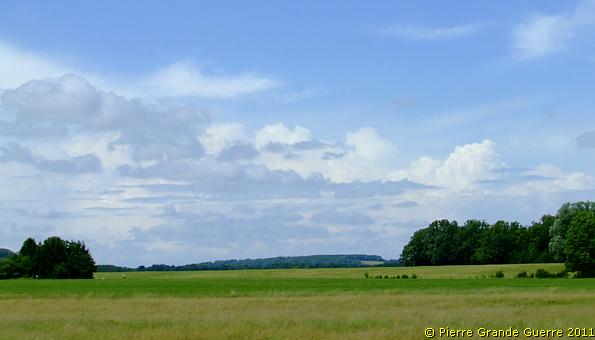
This ugly antenna tower is an important landmark to help you not to miss ...
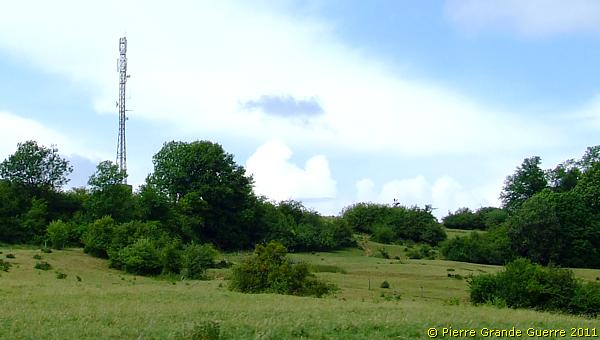
... the Bayon Nécropole Nationale on the other side of the hill on the west side of the road.
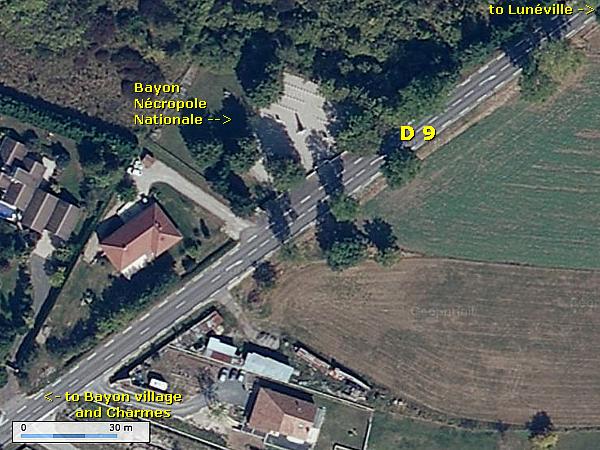
Bayon Nécropole Nationale
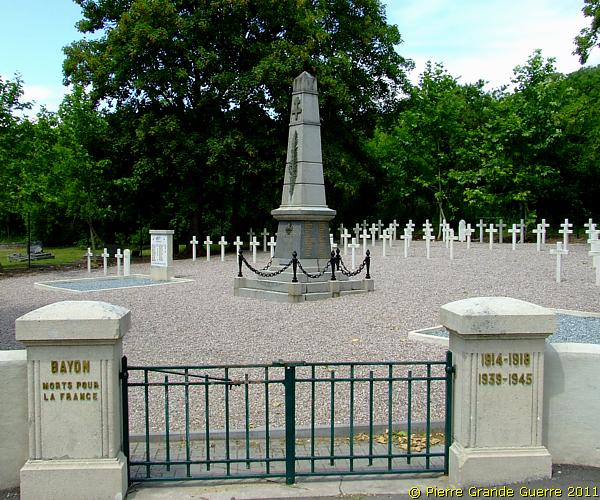
According to the records the
Bayon Nécropole Nationale
contains
the human remains of 169 men. I estimate this number as being higher, because
the communal graves contain more men than the official records do tell us.
There are 100 individual graves and two large communal graves, containing
together the human remains of 71 men. There are also several communal
graves, marked with a white cross, each containing the human remains of 10
men. The majority of officers and soldiers, buried here, were killed during
the Battle of the Grand Couronné of September 1914. You will find also here
graves of French and Polish soldiers, killed during the Second World
War.
Ossuary No. 1.
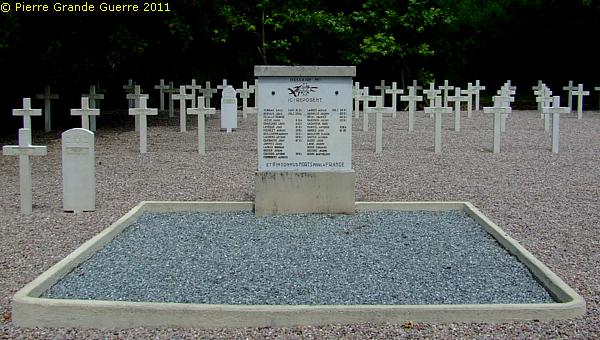
Ossuary No. 2.
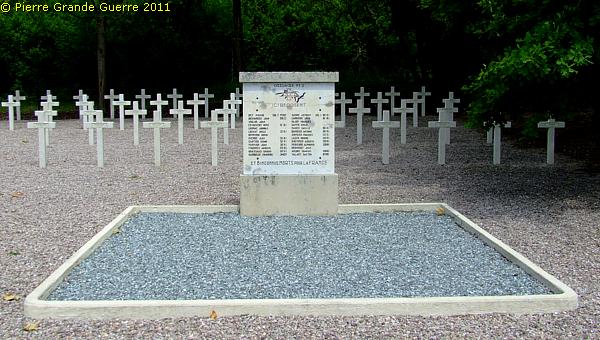
Some of the communal graves, shared by 10 soldiers.
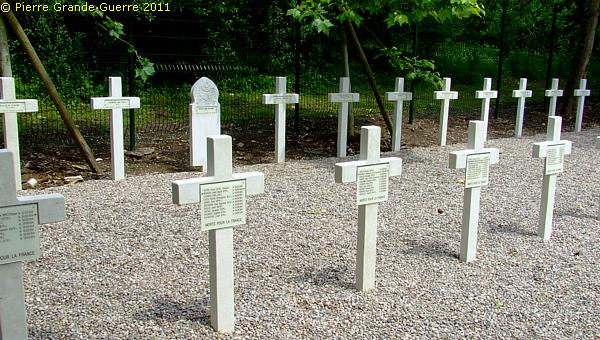
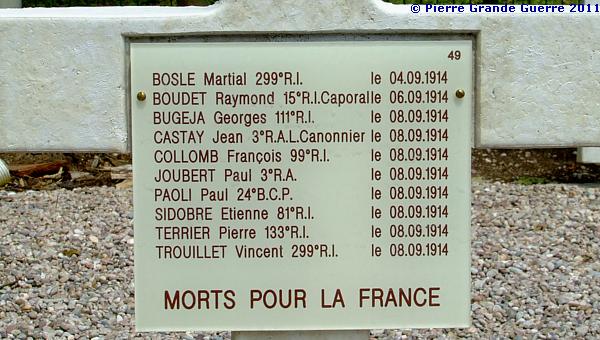
We leave the cemetery.
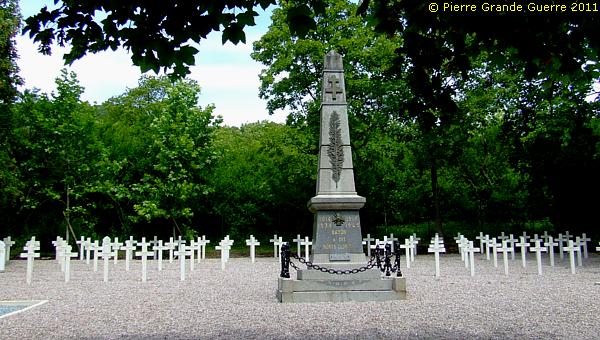
At the nearby village of Bayon we cross the bridge over the Moselle.
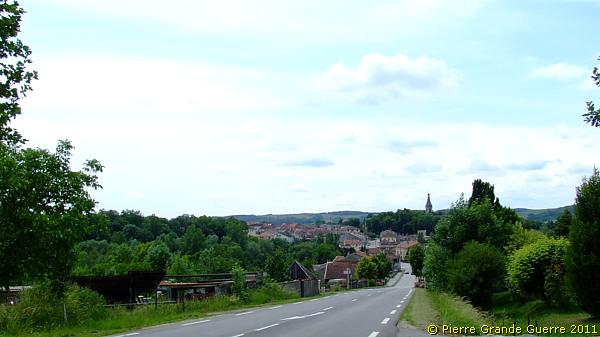
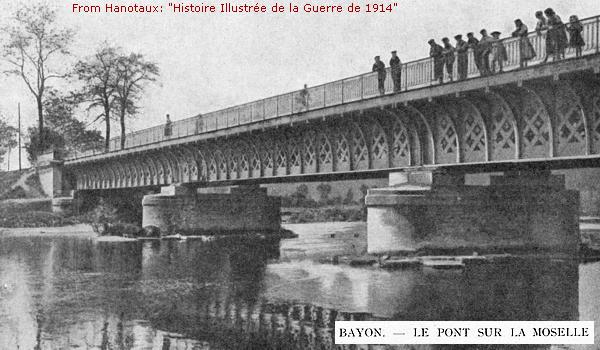
We continue southward to Charmes, where we pass the centre of the town, to go directly southward, to the Haut du Mont.
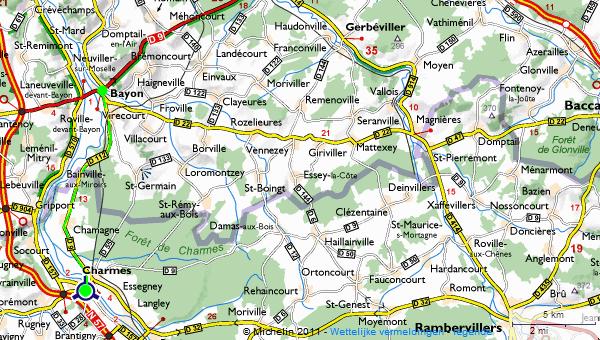
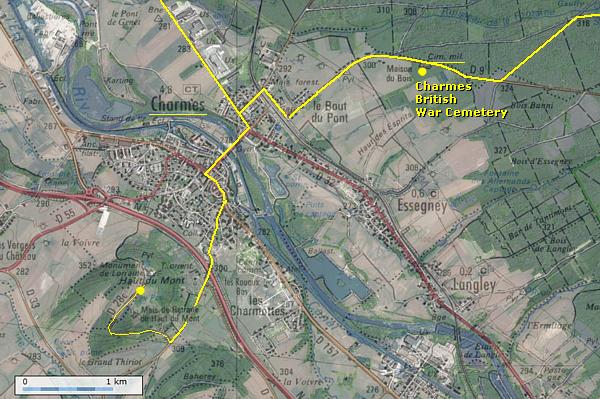

At the Haut du Mont (384 m.) stands this memorial, the " Monument de Lorraine ".
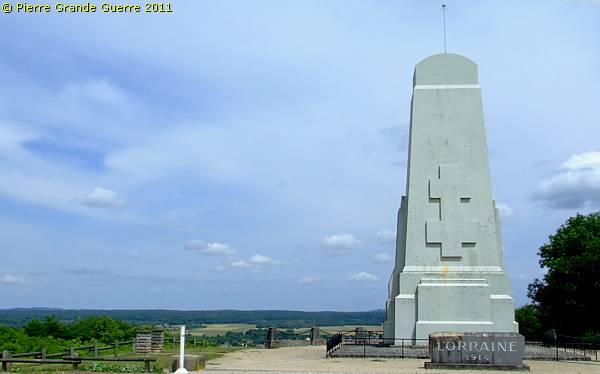
A sign tells us some information about the inauguration of this memorial to commemorate the Battle of the Trouée de Charmes.
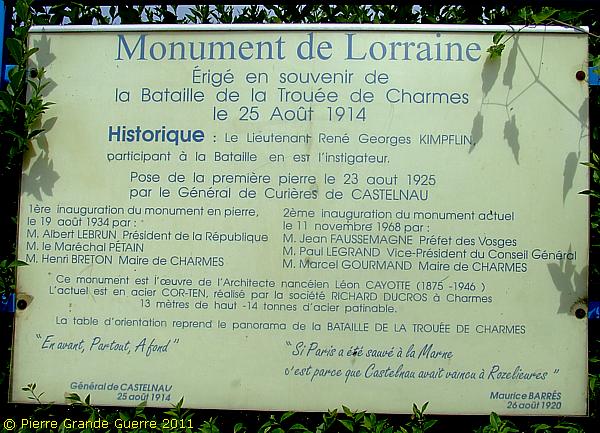
“
Memorial of Lorraine
Erected to commemorate the Battle of the Trouée de Charmes on 25 August 1914.
History: The Lieutenant René Georges Kimpflin, participator in the battle, was the initiator of it.
The first stone was laid on 23 August 1925 by Général Curières de Castelnau.
The first inauguration of the memorial in stone took place on 19 August 1934 by:
M(onsieur) Albert Lebrun, President of the Republic, M. Marshall Pétain, M. Henry Breton, Mayor of Charmes.
The second inauguration of the actual memorial took place on 11 November 1968 by: M. Jean Faussemagne, Prefect of the Vosges, M. Paul Legrand, Vice-President of the General Council, M. Marcel Gourmand, Mayor of Charmes.
This monument is the work of the Nancy architect, Leon Cayotte (1875-1946).
The actual memorial in reinforced concrete has been realised by the Richard Ducros Company in Charmes. Height 13 metres – 14 tons of steel hardened concrete.
The orientation table explains the panorama of the Battle of the Trouée de Charmes.”
The text ends with two quotations:
Left
: “Forward, Everywhere, at the Utmost!” - Général de Castelnau, 25 August 1914
Right
: “If Paris has been saved at the Marne, it is because de Castelnau won at Rozelieures”. - Maurice Barrés, 26 August 1920"
"The orientation table explains the panorama of the Battle of the Trouée de Charmes.” , says the sign.
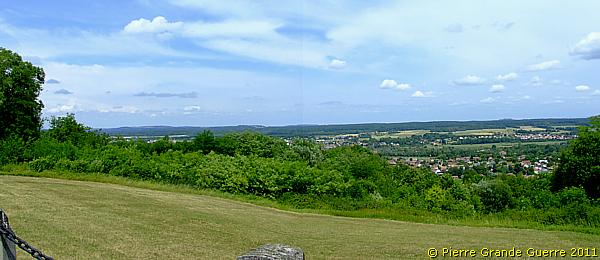
This time 2 panorama views clockwise northward from the Haut du Mont over the battlefield, interchanged by some televiews.
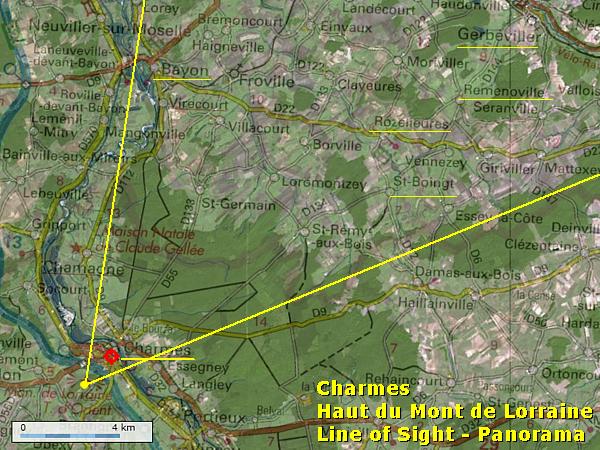
A view northward into the direction of Bayon.
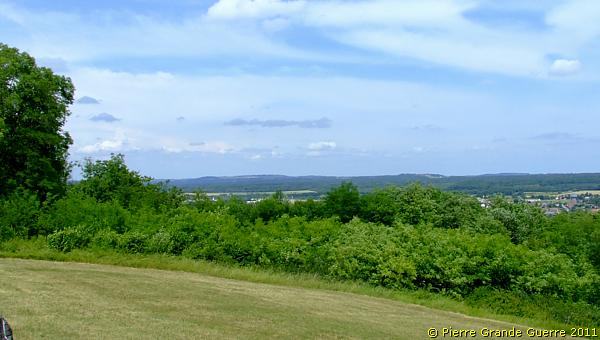
Two overlapping televiews of this part of the battlefield.
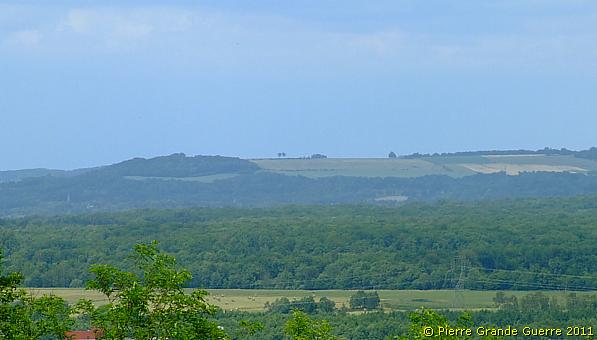
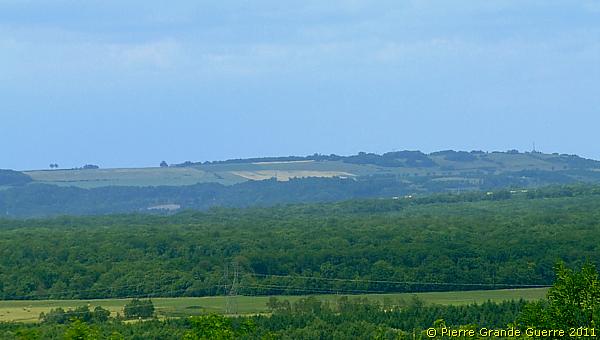
View north-eastward over the town of Charmes .
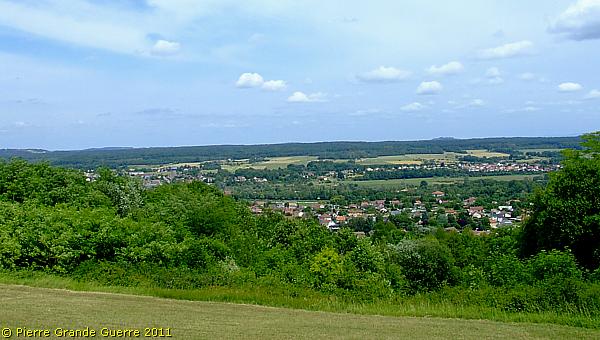
Teleview at Charmes.

We leave the Monument de Lorraine at the Haut du Mont.
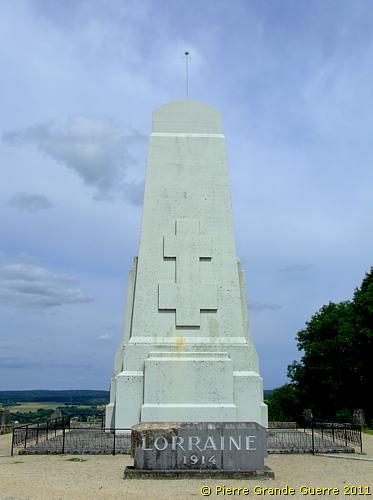
We return to the town to cross there the Moselle, and we continue north-eastward along the D 9, to visit on our way to Rozelieures the British Charmes Military Cemetery .

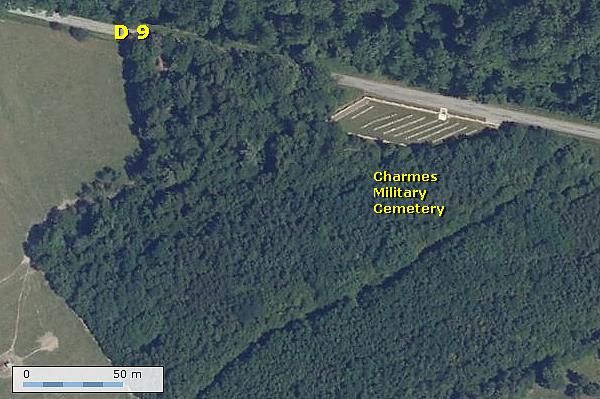
For a while we step out of the period of 1914, to jump forward to the year 1918, the period, during which the majority of the men buried here, were killed.

The majority of the graves belongs to airmen, but also to men of many different nationalities.
Charmes Military Cemetery

Charmes Military Cemetery was used by the 8th Canadian and 42nd Stationary Hospitals and enlarged after the Armistice when graves were brought in from BAZOILLES-SUR-MEUSE French Military Cemetery, BOSSERVILLE and CHARMES Communal Cemetery Extensions, GERARDMER Communal and French Military Cemeteries, ROUCEUX French Military Cemetery, SAVIGNY Churchyard and TOUL American Cemetery. The cemetery now contains 202 burials and commemorations of the First World War. Three of the burials are unidentified and there is a special memorial to one casualty buried in NEUFCHATEAU Communal Cemetery whose grave could not be found. The cemetery also contains 13 Second World War burials and three war graves of other nationalities.
Source as always: Commonwealth War Graves Commission - http://www.cwgc.org/
The records do not mention the presence of graves of members of the Indian Labour Corps and the Chinese Labour Corps . The registry of the cemetery itself tells us also about the initiative of the Royal Air Force:

The headstones of the British R.A.F. airmen are standing almost "shoulder to shoulder".
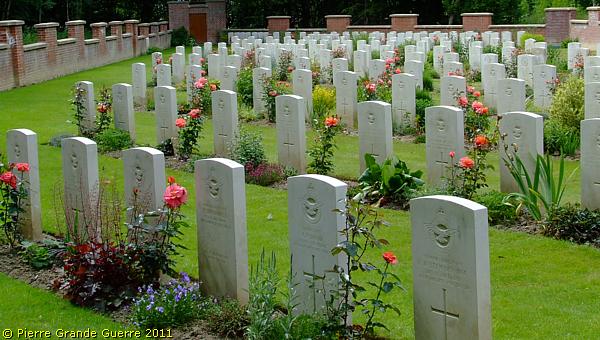
The Royal Air Force was founded on 1 April 1918 by the amalgation of the Royal Flying Corps (RFC) and the Royal Naval Air Service (RNAS).
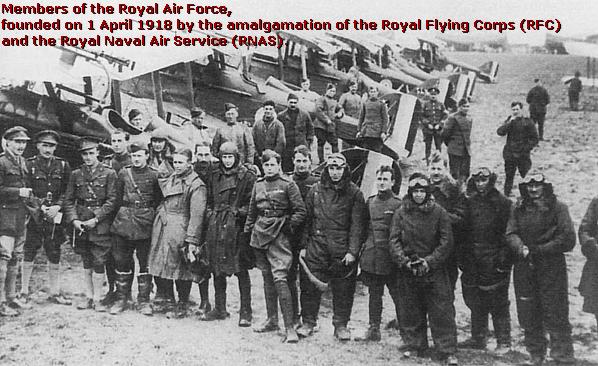
This crew of air mechanics was killed three days before Armistice, on 8 November 1918.

These two R.A.F. Second Lieutenants fell on 14 May 1918.
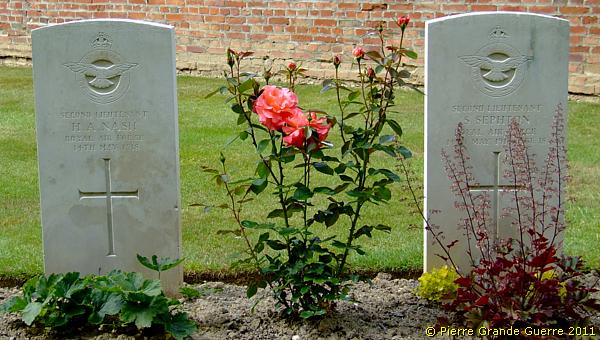
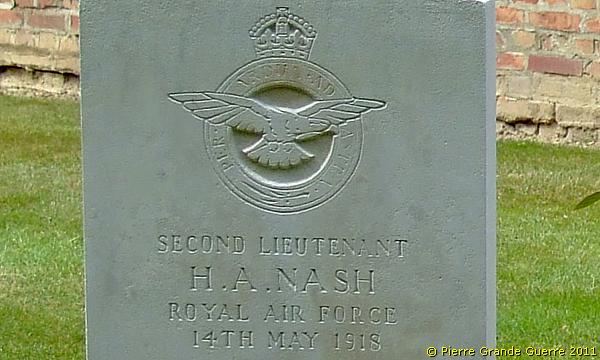
This Lance Corporal of the Royal Irish Fusiliers died after the Armistice. I presume he died after all of his wounds.
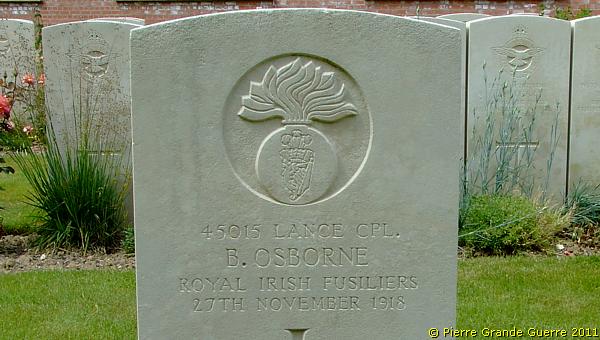
I presume that his fate has been shared by this Canadian Lance Corporal, who died on 6 December 1918.
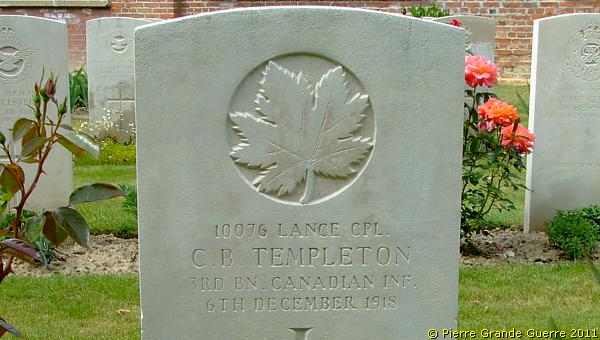
Inscriptions in Hindi and Urdu on the graves of members of the Indian Labour Corps.
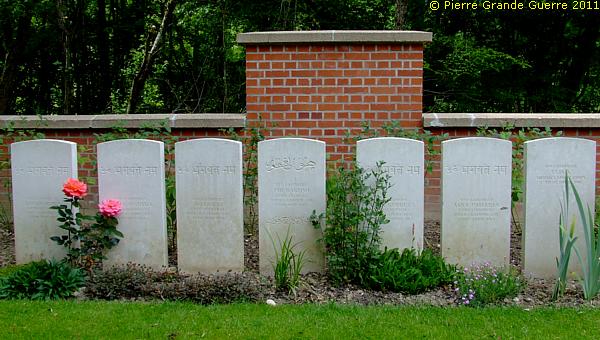
The Indian Labour Corps
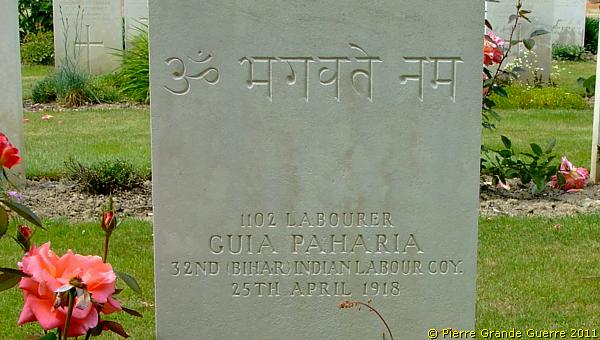
" The Indian Labour Corps
The Indian Labour Corps was employed in Mesopotamia from 1916 onwards. When
insufficient men volunteered the Indian Government recruited men serving
sentences in prisons and created the Indian Jail Labour Corps. Indians
continued to be employed in Mesopotamia until the early 1920s.
Men were recruited in India to serve in the Indian Labour Corps in France
with the first men arriving in June 1917. Each Indian Princely
State and Province recruited their own units, so, on arrival the British
found there were varying restrictions on how they could be used. The length
of their contracts also varied, some being for twelve months and some the
duration of the war.
There were also problems with officers who had little or no military
experience and who had held the rank of Lieutenant Colonel, which meant they
were too senior to command a labour company.
Almost 50,000 Indians served in France in the ILC although as labour units
they were hampered by illness caused by the cold weather and confusion about
their terms of their contract."
Source: "Military Labour During The First World War" . http://www.labourcorps.co.uk/
In a small corner along the wall stand four headstones of members of the Chinese Labour Corps.

The Chinese Labour Corps
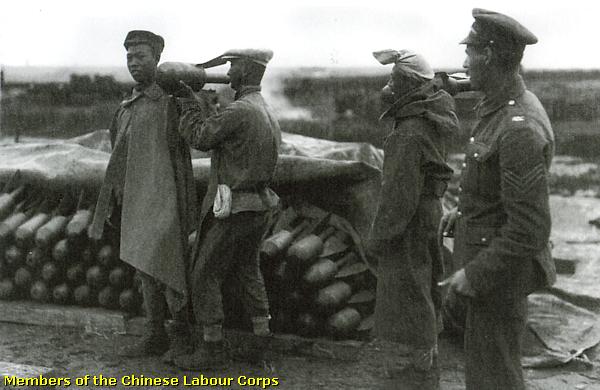
" The Chinese Labour Corps
Recruitment for the Chinese Labour Corps began in China in October 1916 with the first contingent reaching France in April 1917. Almost 100,000 Chinese were to work for the British in France.
Although the Officers and N.C.O.s were British their own Gangers gave instructions to the men and were responsible for supervising the work.
A number of skilled companies were formed and coolies could take trade tests, which entitled them to more pay. 51 and 69 Companies, CLC, for example, undertaking skilled work in the Tank Workshops and almost 2,000 Chinese were employed in skilled railway companies on Railway maintenance.
Following the Armistice the CLC was to undertake major roles as crane drivers at the docks and in battlefield clearance.
The Chinese were recruited on a three year contract and this enabled more continuity than other foreign labour who were often recruited for a year or less. In March 1918 the actions of Ganger Liu Dien Chen in rallying his men when they came under shellfire led to him being recommended for the award of a Military Medal. At the time the Chinese were not eligible for any awards but this was changed to allow them to be awarded the Meritorious Service Medal. As a result Liu Dien Chen and four other Chinese were awarded MSMs.
Chinese labourers were also recruited for service in Mesopotamia and Northern Russia."
Source: "Military Labour During The First World War" . http://www.labourcorps.co.uk/
| A remarkable feature on the photo below: the names of these labourers are carved in Chinese script. The European script only mentions their service number. |

The two graves of the German Airmen, who also died a few weeks after the Armistice .
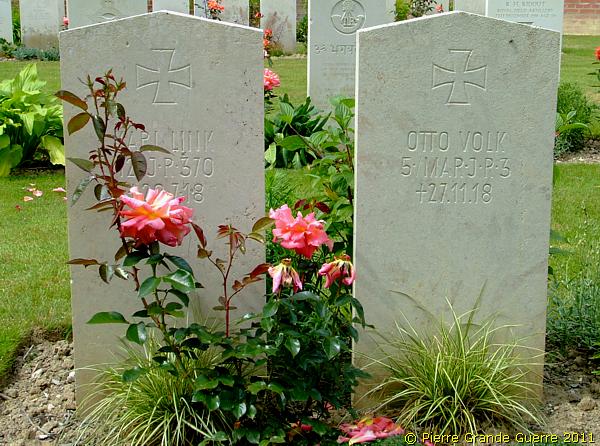
A last view over the Charmes Military Cemetery.
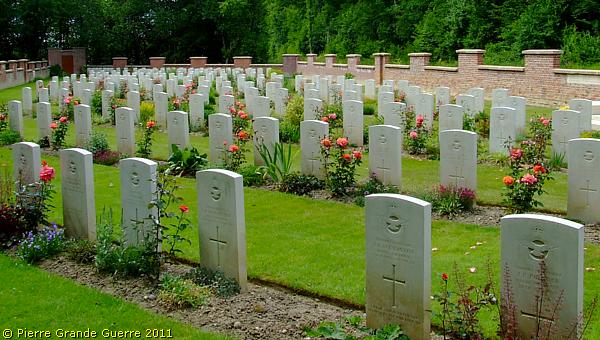
Via Damas-aux-Bois and the D 12, switching at St. Boingt to the D 22d, we continue to Rozelieures .
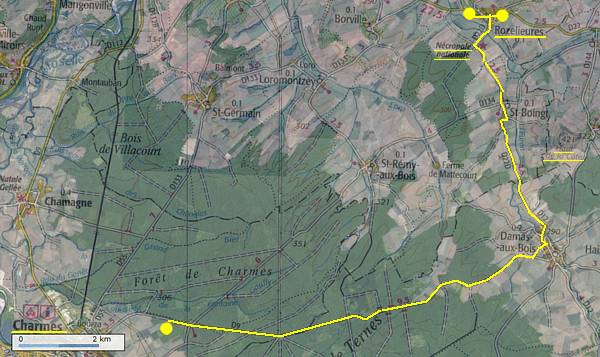
Along the D 12, between Damas-aux-Bois and St. Boingt, we spot on our right the Haut de la Côte (422 m.)
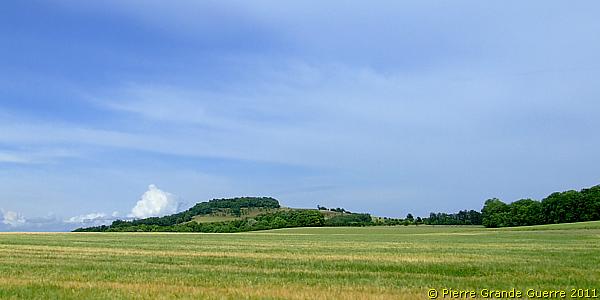
After leaving the village of St. Boingt we get our first impression of the Bois de Réthimont, north-west of the Rozelieures Battlefield .
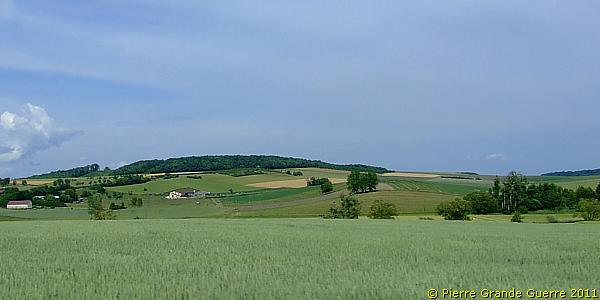
Some satellite photos of the Rozelieures battlefield.
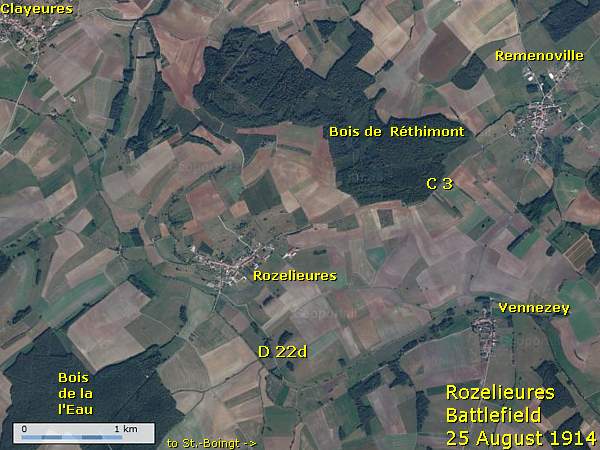
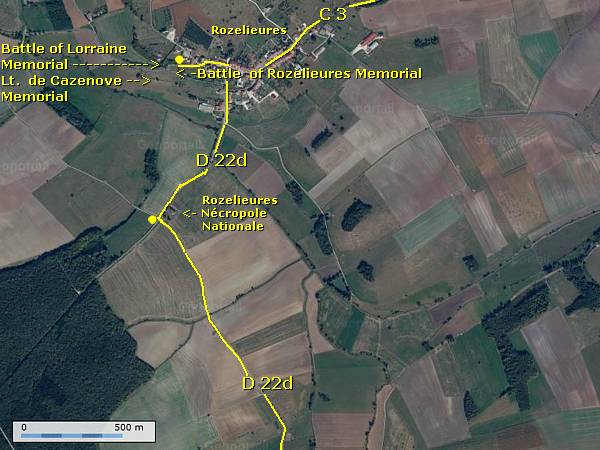

Because we are running late on our planned schedule, we have to skip a visit to the Rozelieures Nécropole Nationale . Of course I still made an overall photo of it.
Nécropole Nationale de Rozelieures
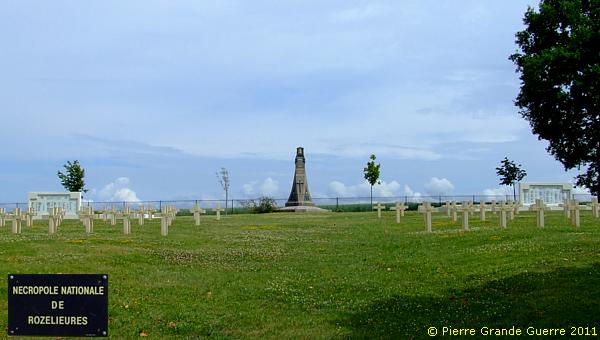
The Nécropole Nationale de Rozelieures contains the human remains of 1,154 men. There are 239 individual graves and several communal graves, containing together the human remains of 915 men. The officers and soldiers, buried here, were all killed here in these fields during the Battle of Rozelieures on 25 August 1914.
As the cemetery is located almost in the centre of the battlefield, ...
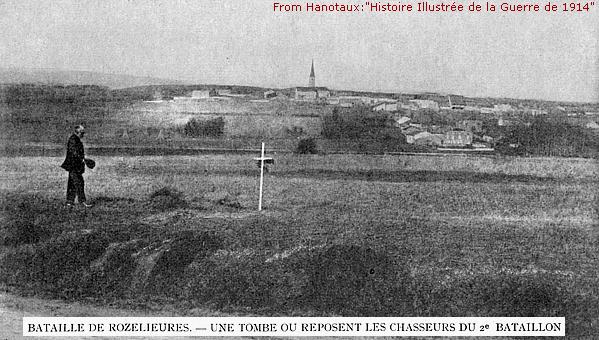
... I made a landscape photo of the battlefield, from the entrance of the Rozelieures Cemetery. Left the edge of the Bois de la l'Éau.
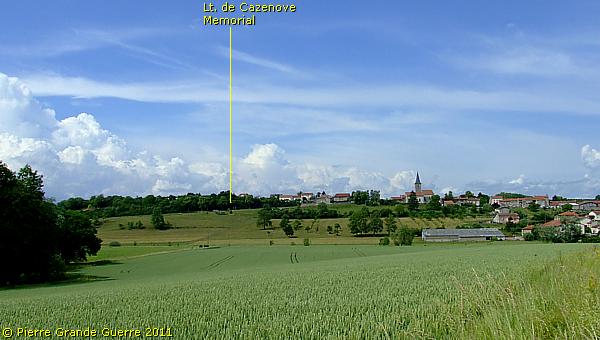
The village of Rozelieures.
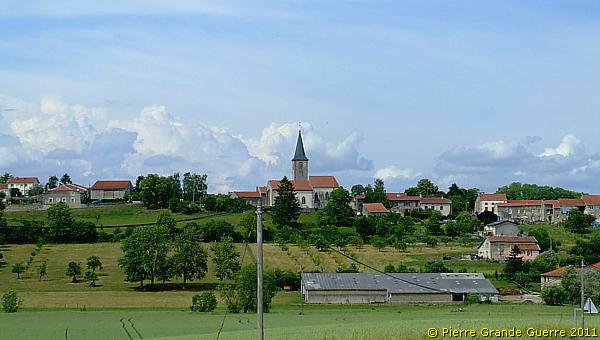
From the cemetery we enter the village, in the village we turn left, and just outside the village we stop at a cluster of memorials.
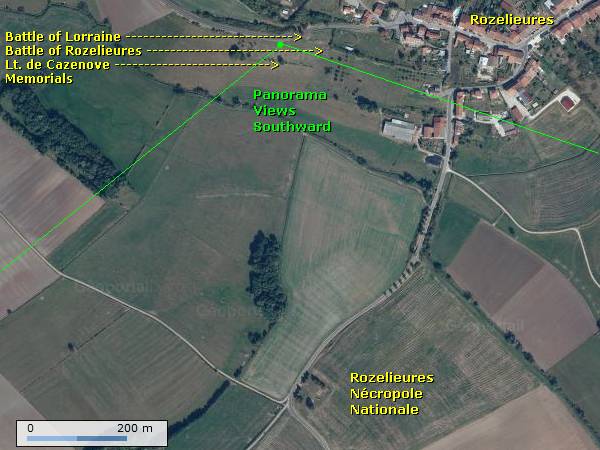
Before we visit the memorials a concise, but still more detailed, reminder about the Battle of Rozelieures of 25 August 1914.
The Battle of Rozelieures - 25 August 1914 - France's First Victory
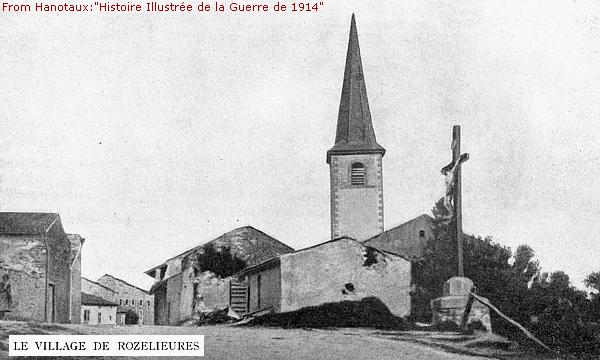
On 24 August units of the 21. Armeekorps reached Gerbévillers, Remenoville and Rozelieures. General de Castelnau’s units counterattacked in a pincer movement from the east and west the flanks of the 21. Armeekorps.
At St. Boingt the 8e Corps d’Armée repelled the attack of the units of the Bavarian 3. Infanterie Division , the B.I.R. 17 , B.I.R. 22 , and the Prussian I.R. 71 . But the Bavarian units still succeeded in occupying the village of Rozelieures.
During the night of 24-25 August de Castelnau ordered to concentrate almost all artillery fire on the centre of the battle zone near the village of Rozelieures.
In the morning of 25 August, at 7.00 AM, the 2e Bataillon des Chasseurs à Pied of the 6e Groupe de Chasseurs Cyclistes (light infantry on bicycles) and a half squadron of the 1e Régiment des Hussards (light cavalry) attacked from the northern outskirts of St. Boingt and the Bois de la l’Eau, south of the village of Rozelieures, entered it and almost captured it.
From 8.00 AM the French units received fierce counter-attacks from support units of the 3. B.I.D., advancing from Remenoviller and the Bois de Réthimont, north of Rozelieures.
The Chasseurs were driven from the village southward to the Bois de
la l’Eau.
The Bavarians took advantage of this success and continued to move
southward, further into the Gap of Charmes.
De Castelnau ordered immediately three regiments of the Cavalry Corps to
advance from St. Boingt and to reinforce the troops fighting in the wood.
With the support of the newly arrived cavalry the 2e B.C.P. successfully
regrouped. Around 16.00 hrs. they launched in the wood "
with a
magnificent elan" a fierce charge with bayonets at the Bavarians,
chasing them out of the wood over the open battlefield, out of the village.
Later on that day there followed fierce fighting in the Bois de Réthimont,
south of Remenoviller and further northward, which caused the Bavarians to
retreat on the 26th over the Meurthe and the Mortagne.
In this battle, Lieutenant de Cazenove is distinguished for his bravery and energy. He fell mortally wounded by 4 bullets some 500 metres from this spot at the edge of the Bois de la l'Eau ( old spelling: "Bois dela Lau") . He wrote in a letter, dated on 17 August: "Victory is certain and with it the recovery of France, our lives would mean nothing to offer for such a blessing. "
According to French sources the Bavarians counted on the 25th at least 2,500 men killed and 6,000 other casualties.
The Battle of Rozelieures ended as a French victory and blocked definitely the advance through the Gap of Charmes.

From the Battle of Rozelieures memorial, a view south-eastward, over the battlefield to the Revers le Renard hill (301 m).
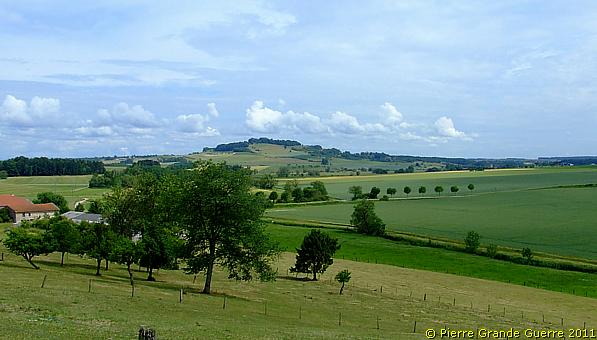
Some 20 m. futher on, on the northern side of the road, stands the Battle of Lorraine memorial.
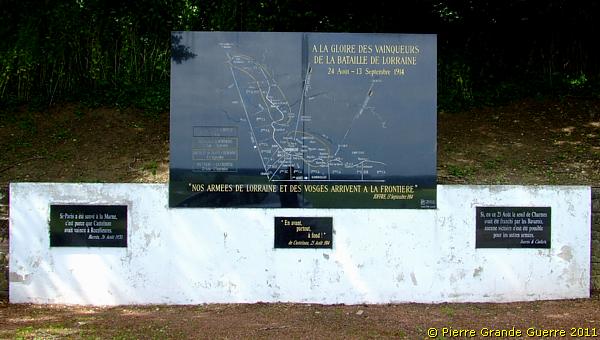
It is dedicated ...

The memorial shows a map of the battlefields of the large 4 battles, the Battle of Rozelieures, the Battle of the Mortagne, the Battle of the Grand Couronné , and the Battle of the Meurthe - Mortagne , here called the Battle of Baccarat - la Chipotte, and it mentions all the units of the 1e and the 2e Armée involved in these battles.
On the memorial we find three quotations, referring to the decisive influence of these battles on the results of the Battle of the Marne . We have read already two of these quotations at the Monument de Lorraine, Charmes. The third quotation is of the veterans, Isorni & Cadars:

We turn our back for the next view over the Rozelieures battlefield.

Before us we see a crucifix and the grave of the war hero, Lieutenant de Cazenove.
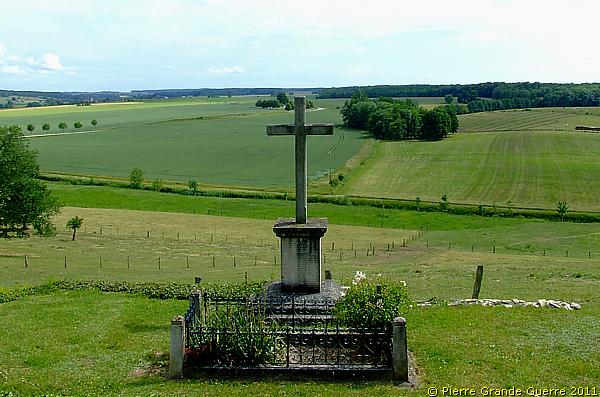
On the base of the crucifix is an inscription with an elaborate, but interesting text.
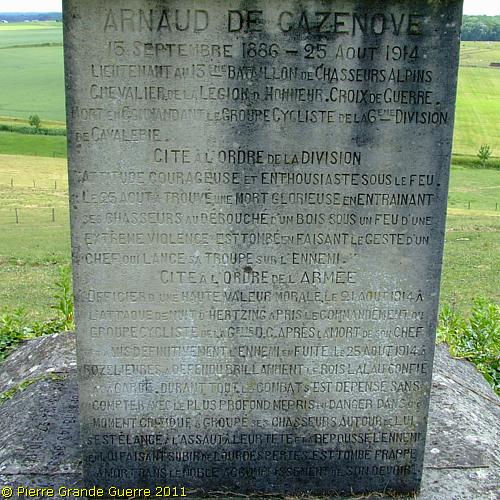
"
Arnaud
de Cazenove
, 15 September 1886 – 25 August 1914.
Lieutenant of the 13e Bataillon de Chasseurs Alpins, Knight of the Legion of
Honour, Croix de Guerre. Died being the group commander of the Group of
Cyclists of the 6th Cavalry Division
(21-08 - 25-08-1914) . Cited in the
Order of the Division: courageous attitude and enthusiastic under fire.
On 25 August
(de Cazenove) found a glorious death leading
his light infantry men into the opening of a wood under a fire of extreme
violence.
(He) fell making the gesture of a leader, who launches his troops
against the enemy. Cited in the Order of the Army: Officer of a high moral
value. On 21 August 1914 during the night attack of Hertzing he took
command of the Group of Cyclists of the 6e D.C. After the death of its
commander (
taking over also its command) he definitely caused the enemy to
flee. On 25 August 1914 he defended brilliantly Rozelieures. The Bois La Lau
(old spelling for the modern name of Bois de la l’Eau) was entrusted
to his guard. During all combats, without counting his personal safety,
with the most profound contempt for danger, he did his best during the
critical moment to gather his light infantry men around him. At the
head
(of his group) he launched the assault and forced back the enemy, inflicting on him
heavy losses. He fell, beaten to death, in the noble fulfilment of his
duty."
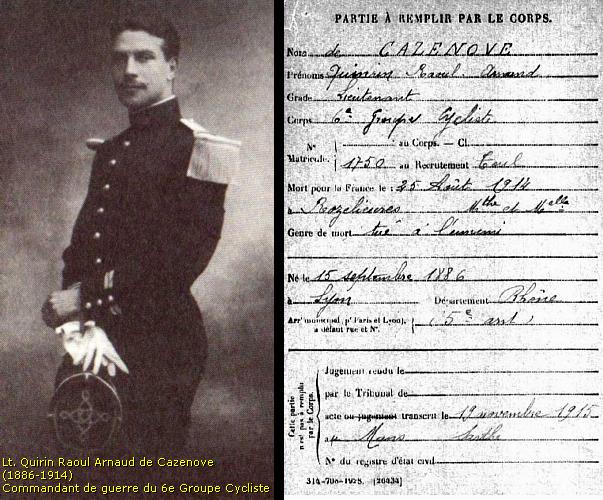
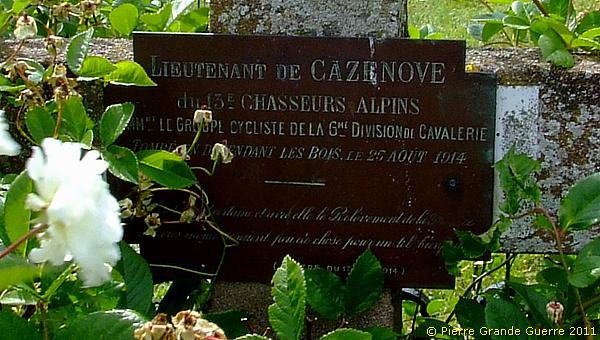
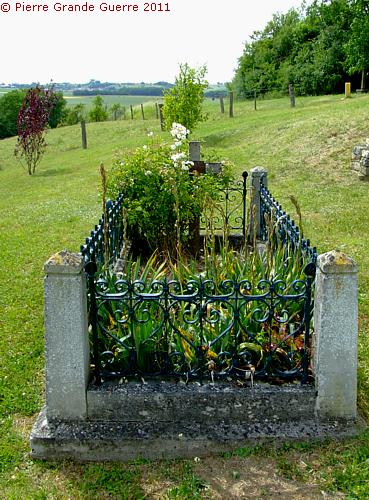
This period photo of the grave and the village has been taken from the western side of the grave.
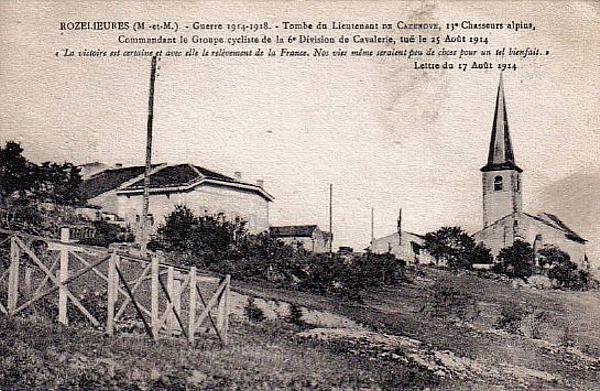
Let us have an extra and better look at the panorama, which this spot offers.

The Nécropole Nationale, along the D 22d, is located left of the top of the crucifix. The Bois de la l'Eau ( Bois dela Lau ) is located right at the horizon.

A teleview to the Rozelieures Nécropole Nationale.
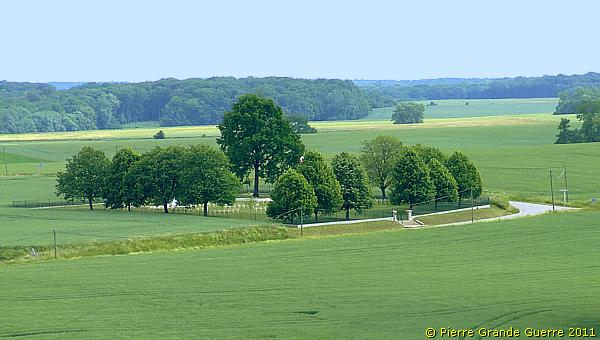
The Bois de la l'Eau.
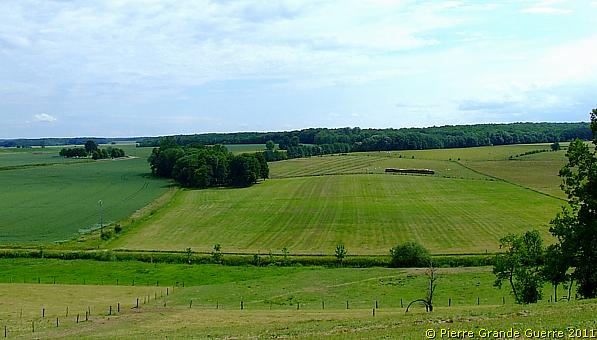
With some period photos in our mind we leave Rozelieures.
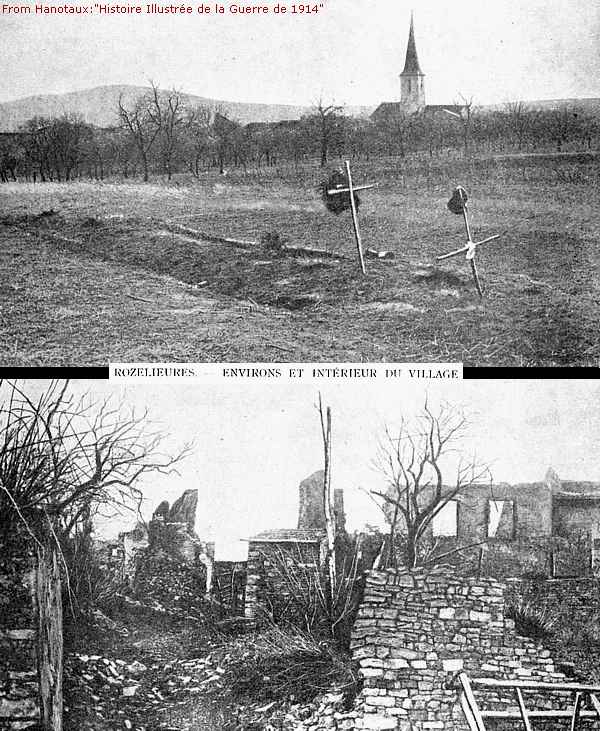
Via Remenoville we continue ...
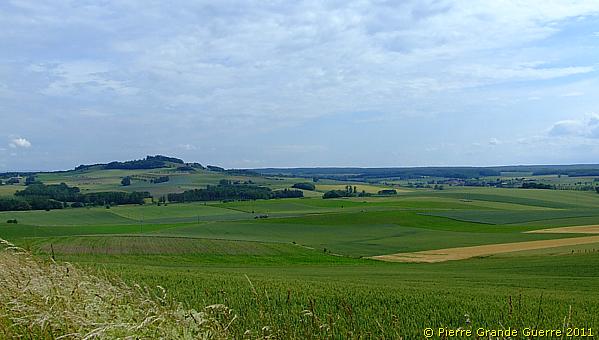
... northward via the D 144 to Gerbéviller . In the centre of the village we visit an important location: the Bridge over the Mortagne river .

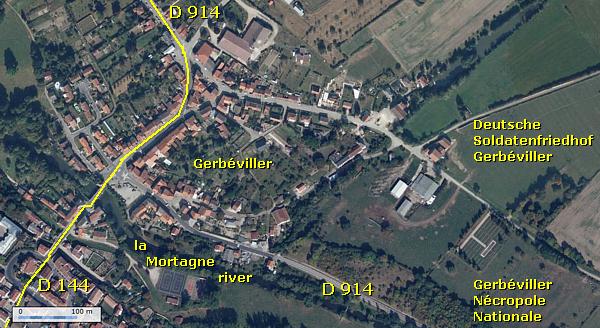
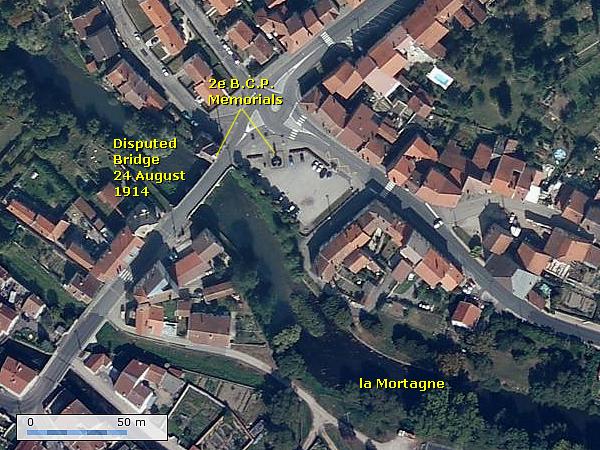
On the northern bank of the river stands near the bridge this memorial, dedicated to the inhabitants of Gerbéviller and the 2e Bataillon de Chasseurs à Pied.
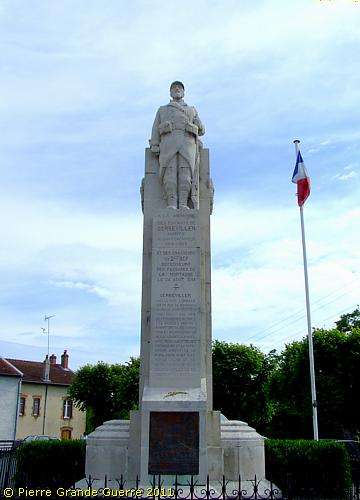

"IN MEMORY OF THE CHILDREN OF GERBEVILLER, WHO DIED ON THE FIELDS OF HONOUR 1914-1918 AND THE CHASSEURS OF THE 2E B.C.P., DEFENDERS OF THE PASSAGES OVER THE MORTAGNE ON 24 AUGUST 1914
+
GERBEVILLER, GRAND CITY OF LORRAINE, WHICH WAS DURING THE MONTH OF AUGUST 1914 BY REASON OF ITS ADVANCED POSITION ONE OF THE FIRST VICTIMS OF THE ENEMY HORDES, PAYING FOR THIS WITH ITS DESTRUCTION AND WITH THE MARTYRDOM OF ITS INHABITANTS.
THE GALLANT RESISTANCE OF ITS DEFENDERS AND THE ARDENT PATRIOTISM OF ITS POPULATION WITH THEIR CALM AND PROUD ATTITUDE WILL STAY FOREVER ONE OF THE FINEST EXAMPLES OF DEDICATION AND SELFLESSNESS"
We walk some 30 metres to the bridge. On 24 August 1914 this bridge formed an important site of action.
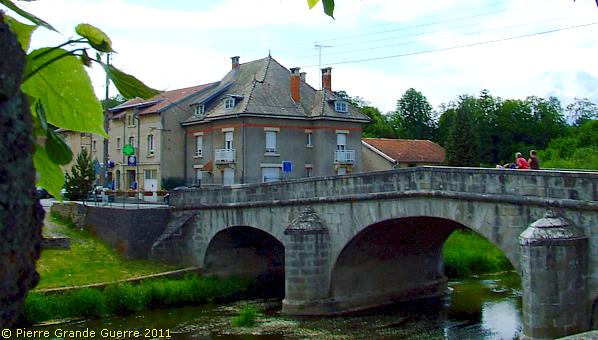
A marble plaque tells us: ...
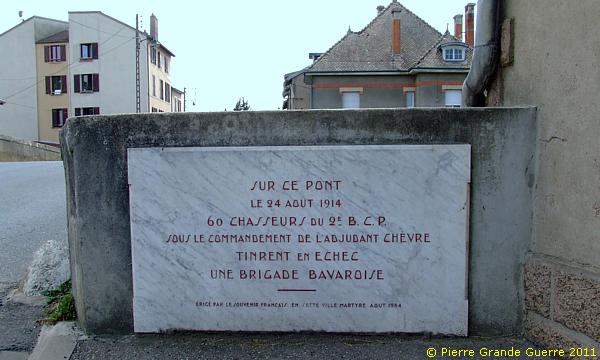
The fights for the Gerbéviller Bridge
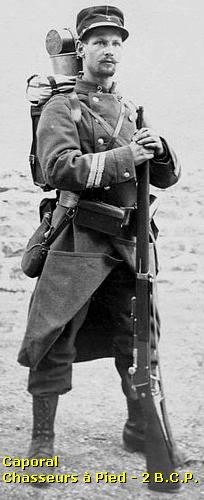
After an artillery bombardment during the night of 23-24 August from Fraimbois, north of Gerbéviller, the Bavarian I.R. 17 entered in the morning around nine o’clock the northern part of the village.
The B.I.R. 17 was a unit of the Bavarian 6. Infanterie Brigade, commanded by General von Clauss, a component of the Bavarian 3. Infanterie Division. The 3rd and 4th Bavarian Infantry Divisions formed together the Bavarian 2nd Army Corps, and in 1914 this corps was attached to Rupprecht's 6. Armee.
When the Bavarians reached this barricaded bridge, they met fierce resistance of 54 Chasseurs of the 2e B.C.P., commanded by 2nd Lt. Chèvre. It was their mission to give the units of the 8e Corps d'Armée just enough time to retreat and to reorganise in the south. Although it was in fact a Bavarian regiment and not a whole brigade, this small unit of Chasseurs successfully blocked the passage over the Mortagne of the units of the B.I.R. 17 and the rest of the Brigade for a whole day.
After inflicting heavy losses on the Bavarians, but also after having taken themselves many casualties, the Chasseurs retreated, unseen in the dark of the late evening.
Bavarian atrocities
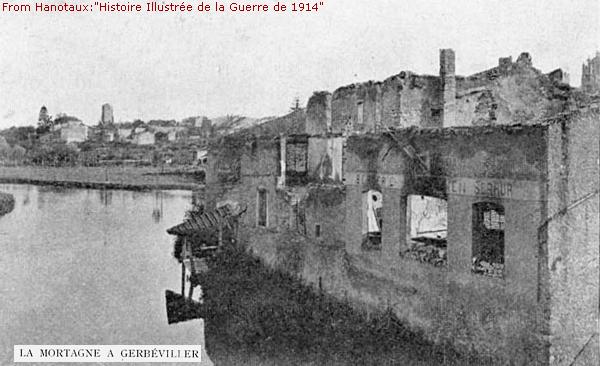
This blockade frustrated the Bavarians so much, that their anger resulted in atrocities against the Gerbéviller citizens on 24 August; all kinds of violence took place, also against women and children. The Bavarians started to loot and to set fire to the few last buildings of the town, which were still standing after the bombardent. Later on that day they evacuated with force a part of the population.
Afterwards, on 1 September, the French civilian aviator, Doctor Emile Reymond, flew over the ruins of Gerbéviller and observed that the ruins of Gerbévillers were still burning.
Of the 475 houses only 20 houses stayed intact. Some 100 civilians of Gerbéviller are still missing, another 50 persons were killed. At a location, called la Prêle, north-west of the town, the Bavarians executed 15 inhabitants.
On the 25th the 8e Corps d'Armée liberated temporarily Gerbéviller until the next Bavarian occupation of 5 - 12 September 1914.
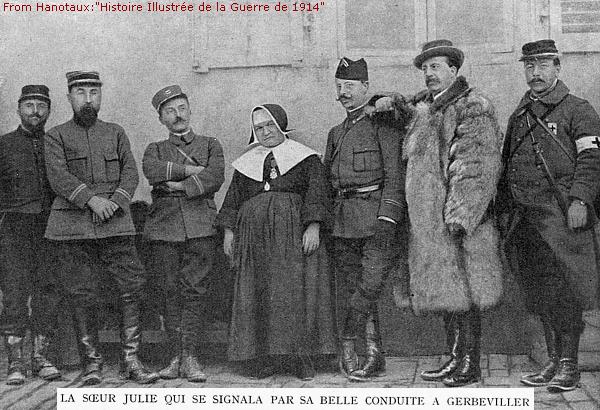

From the bridge we continue through the village to the north-western outskirts of Gerbéviller. For lack of time we have to skip our visit to the two Gerbéviller war cemeteries, east of the village. Instead we prefer to visit the location, where the execution of the 15 civilians took place, near the Monument de la Prêle .

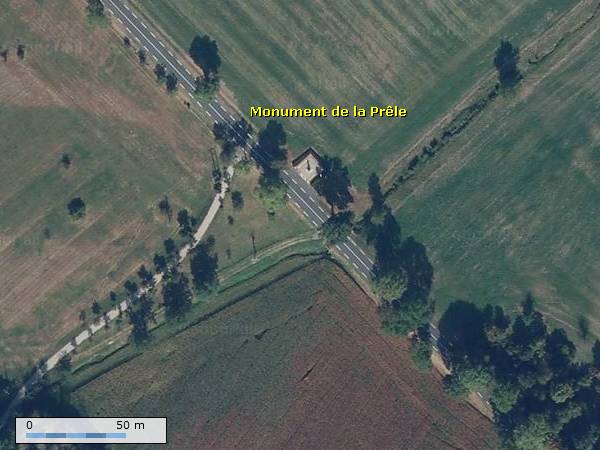
The la Prêle Memorial commemorates the civilian victims of 24 August 1914 of the hamlet of Tanconville, west of Gerbéviller, and of Gerbéviller itself.
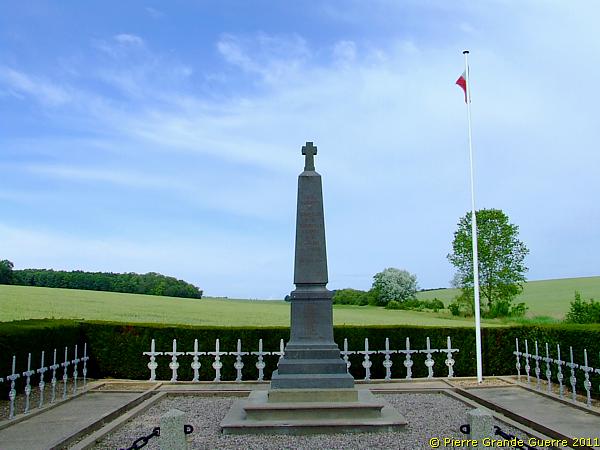
Most of these civilian victims are buried here.

The four sides of the base of the obelisk wear the inscriptions of the names of these citizens.

Three rows of approximately 15 graves each "surround" the obelisk.
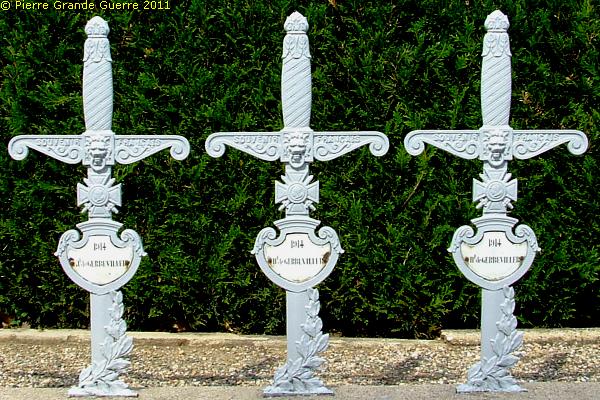
The headstones are in the shape of a sword in blue horizon, decorated with a lion's head, the citizen's name and simply "1914".
" Le Souvenir Français ", "The French Remembrance", is an official French, and also a private, association, since 1887 responsible for creating and maintaining the majority of the war memorials in France.
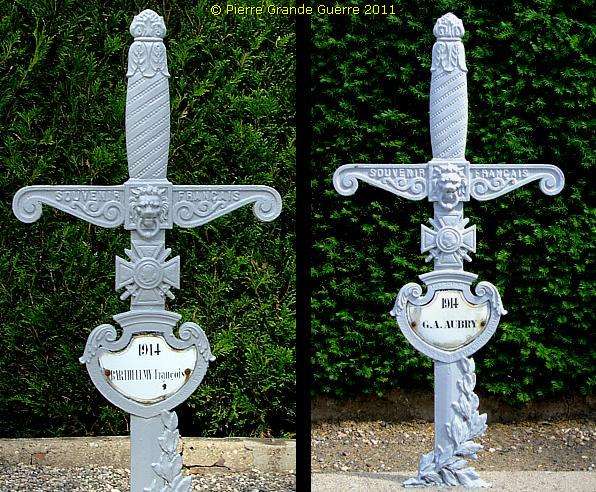
On this spot, or nearby, General Clauss himself attended the execution of the 15 Gerbéviller citizens.
About the execution near the Monument de la Prêle the French official war historian of the period, Gabriël Hanotaux, records in a modest footnote a handwritten note of the eye-witness, Soeur Julie:
“During this execution General Clauss was sitting under an ash tree behind a table with a bottle of champagne, when he ordered to shoot at the moment that he raised his glass.”
( Source: Hanotaux: “L'Histoire Illustrée de la Guerre de 1914”)

We continue via Lunéville to Manonviller, where we pass the village to pay a short visit to the ruins of the Fort de Manonviller .
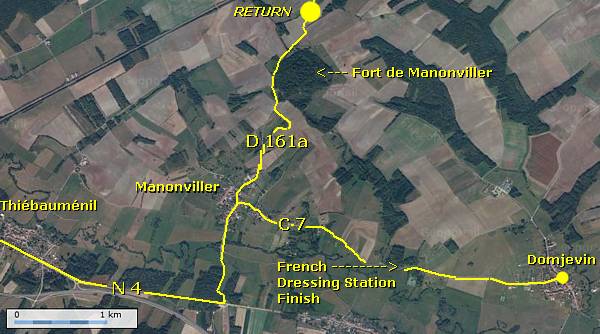


This view from the north is the best view, which I can offer you of the location of the ruins of the Fort de Manonviller , overgrown with vegetation.
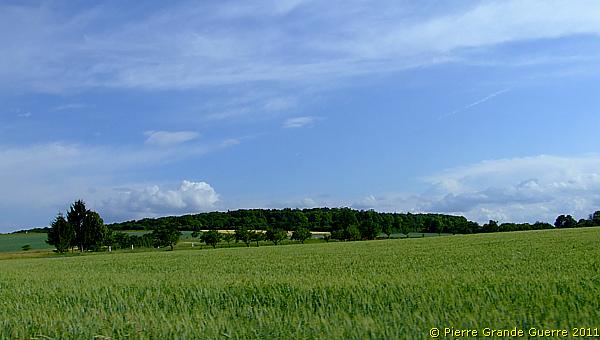
Experienced fellow travellers of the Front warned me not to enter this time the dangerous and forbidden premises of the ruins, where I might risk at least breaking a limb. As an exception this time I listened to their advice. Instead I show you in the frame below some period photos of the ruins, taken after its destruction.
The Siege of Fort de Manonviller – 25-27 August 1914

The Fort de Manonviller was constructed to defend the valley of the Vezouze and the road to Lunéville.
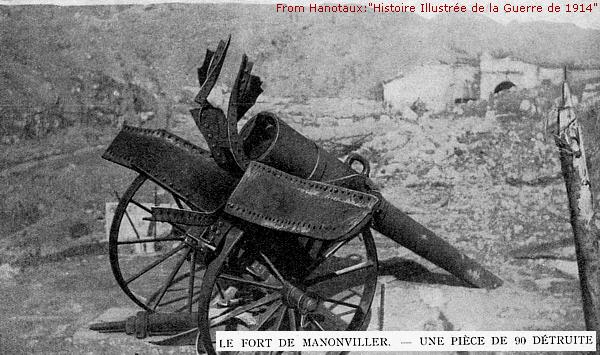
On 2 August 1914 the fort garrisoned 803 artillerymen and infantrymen, composed of units of the 6e Régiment d’Artillerie, the 26e Bataillon de Génie (engineers) and the 167e R.I., all commanded by Chef de Bataillon, Commandant Jean Rocolle. The fort possessed at least 8 armoured 155 mm. gun turrets.
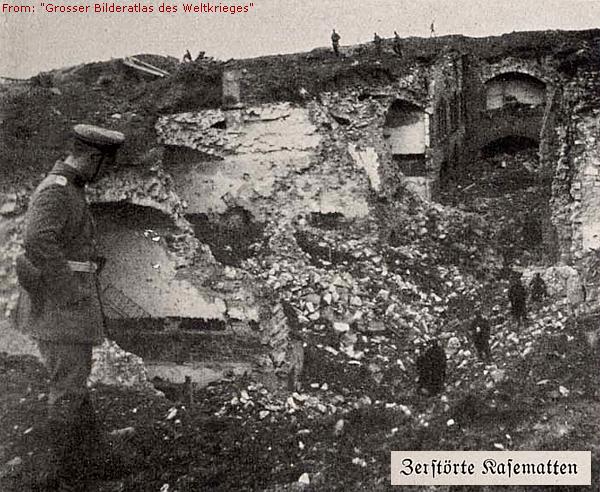
On 25 August in the morning the Fussartillerie Regiment 18 started an artillery bombardment with large calibre shells, which would last until the late afternoon of 27 August. The Fussartillerie Regiment 18 used from Avricourt ( Elfringen ) also two heavy 420 mm. artillery guns. They fired their first shells during the evening of the 25th. One of the first artillery shots was sufficient to destroy the main armoured gun turret of the fortress.
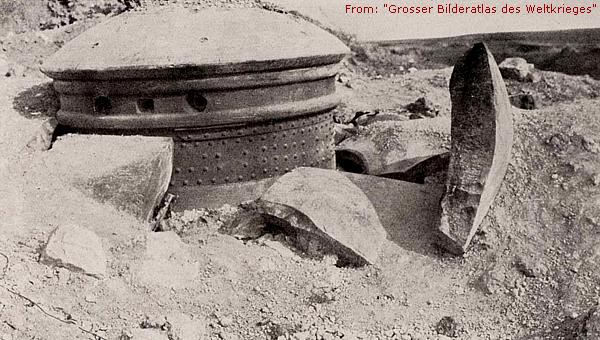
During the bombardment units of the Bavarian 70. Reserve Division, a.o. B.R.I.R 12, and four battalions of Pioniere, components of the Bavarian 1. Armeekorps, all under command of General der Pioniere Ritter von Brug, encircled the fortress. Under protection of their artillery these infantry troops created a circle of barbed wire entanglements around the fort, leaving only one narrow exit.
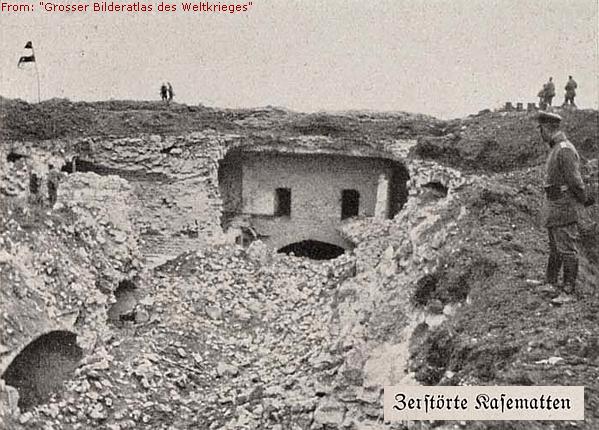
Impressed by the continuous artillery bombardment of 6,000 German shells, demoralised by its total destruction of his defensive works, and intimidated by the Bavarian encirclement of the fortress, Commandant Rocolle telephoned the Bavarians on the 27th and offered them the capitulation of his garrison.
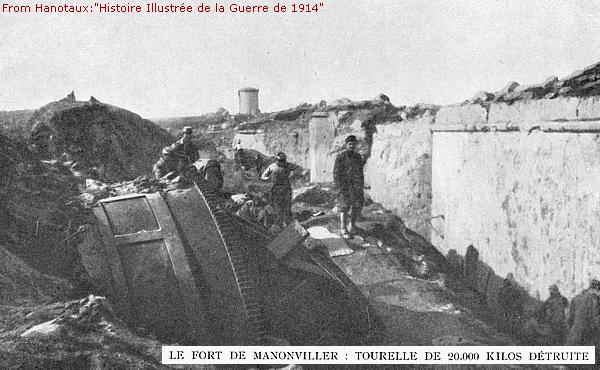
On 27 August 1914, somewhere between 4 and 5 o’clock in the afternoon, Rocolle ordered the white flag to be hoisted and surrendered his garrison to the Bavarians.

Rocolle’s capitulation caused a public discussion in the French media about the question, whether he had surrendered too early or without fighting the Bavarian infantry units.
Considering the later developments during the following month the Bavarian success here was not of any strategic importance, but for the time being it was still better news in the German media than the news of being beaten on the same day at the Battle of Rozelieures.
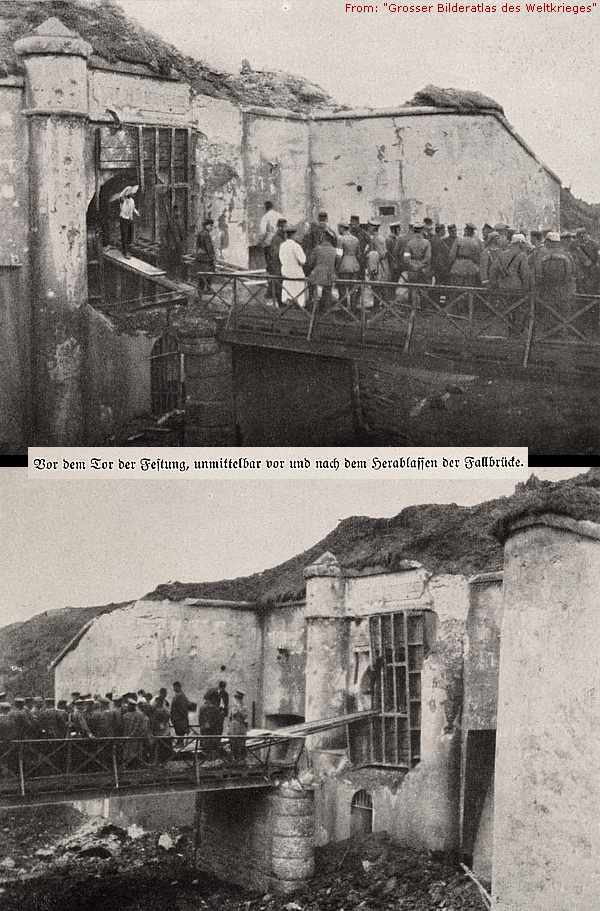
Unfortunately this memorial in front of the fort forms the only site of interest, which we are able to visit.
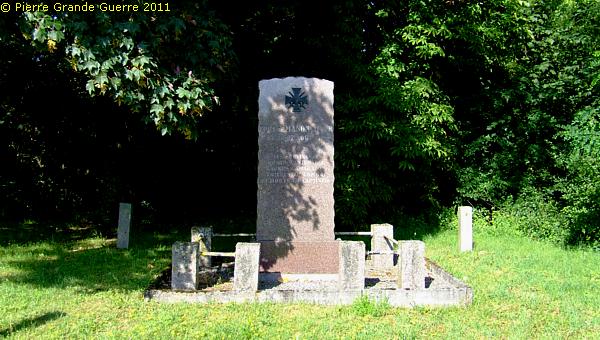
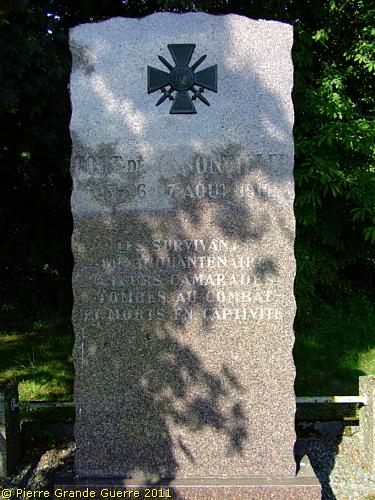
From the fort we return to Manonviller.
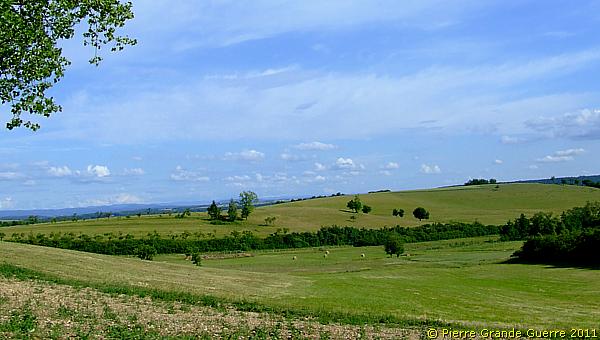
At the centre of the village we go westward along the C 7 into the direction of the village of Domjevin ...
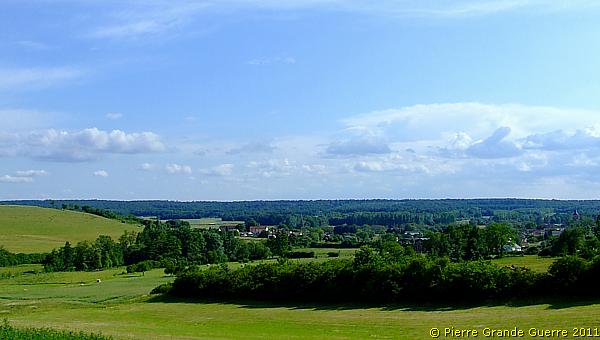
... on our way to a French Dressing Station Bunker .
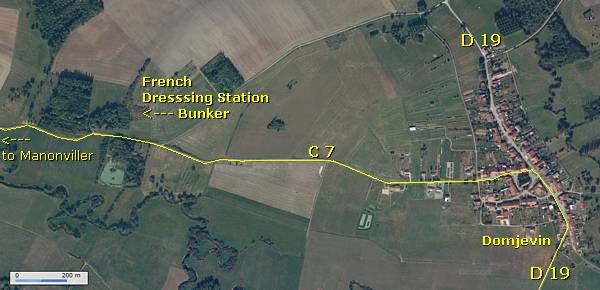

Some 1,5 km. west of the village of Domjevin, and in bird's flight some 2 km. away from the fort de Manonviller, we park our car.
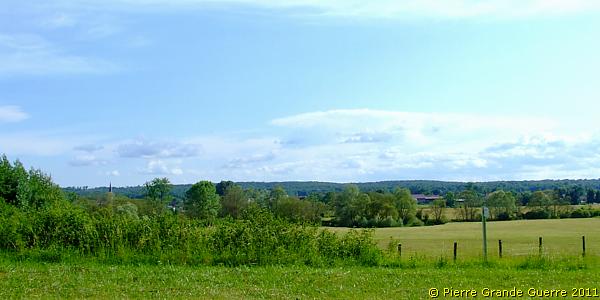
We follow this from the road rather inconspicuous sign:
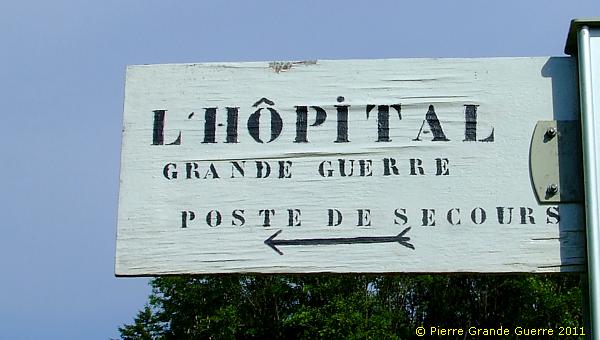
Being not more than 2 km. away from the later consolidated front line of Laneuveville-aux-Bois, Vého and Reillon , it is possible that this bunker functioned as a dressing station, not only during 1914, but also afterwards, until 1918.
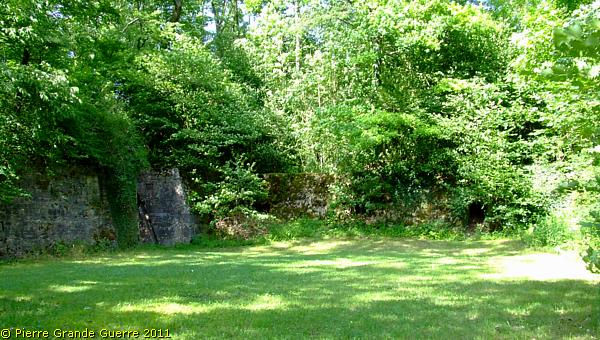
At first we detect in the copse only an open spot with the two eastern entrances of the bunker. The eastern main entrance of the bunker.
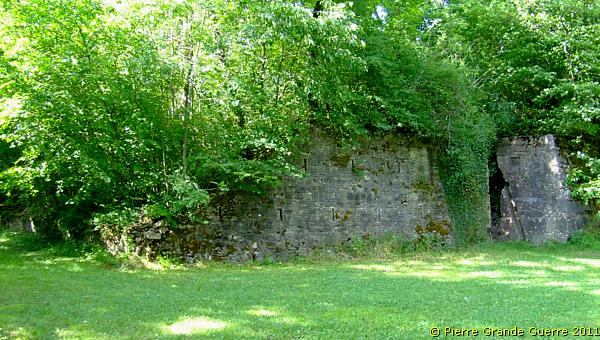
The extreme eastern entrance is almost hidden beneath the vegetation.

As the entrance is partly filled in, I estimate the corridor inward to be not higher than 1,25 m. and about 0,75 m. wide.
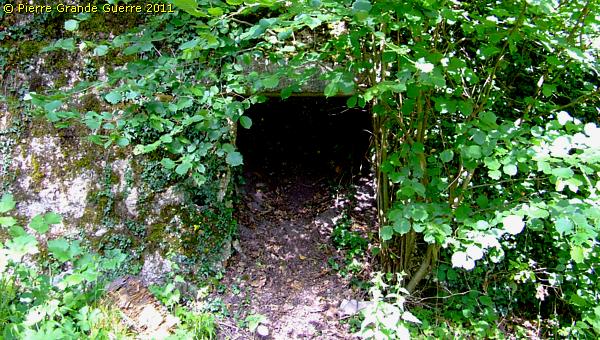
We return to the open spot and follow a long wall westward.

Surrounded by three walls we detect the western main entrance.
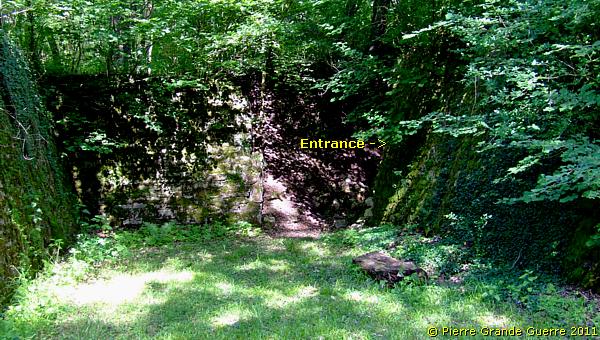
This French concrete is also still of an amazingly good quality.

View from the entrance outside.
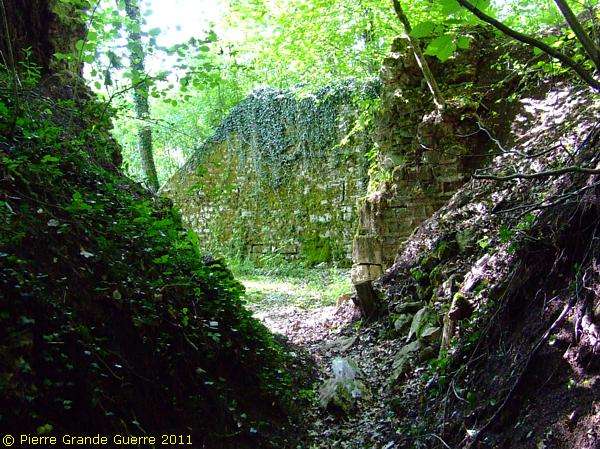
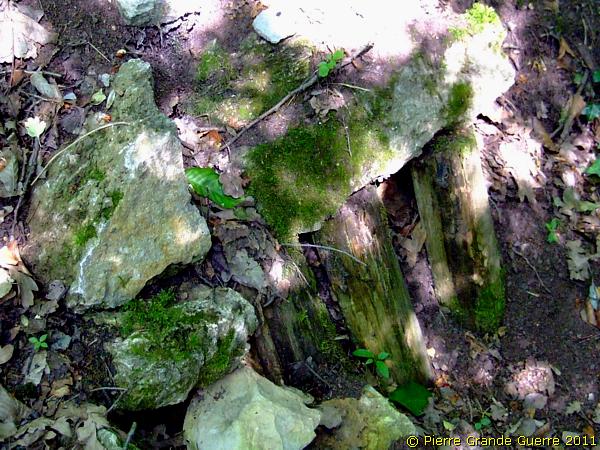
We enter a wide and high arched corridor, with wide door openings.

These corridors are not like the narrow and low shafts, used elsewhere on the front for underground mining activity.
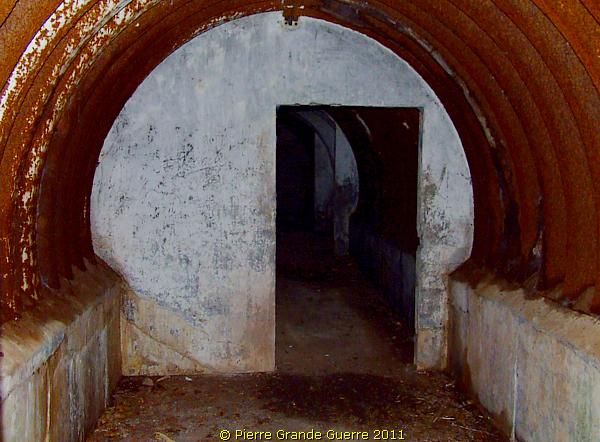
The two in the centre connecting tunnels had to be wide enough to let stretcher parties pass, coming from the front.

A detail of the arched ceiling, where two large rooms come together with the two tunnels.
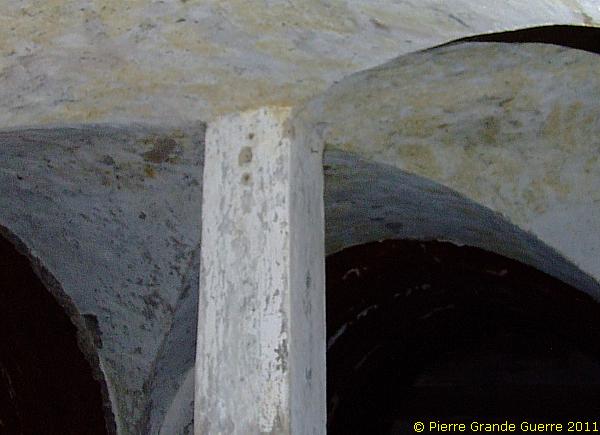
I suppose this room and the one opposite were used for first aid surgery.
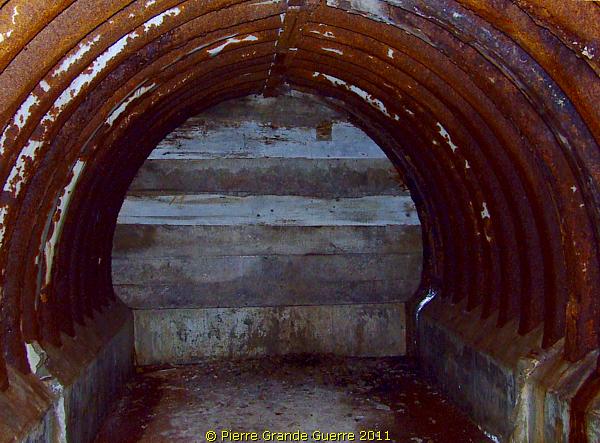
An airshaft in the ceiling.
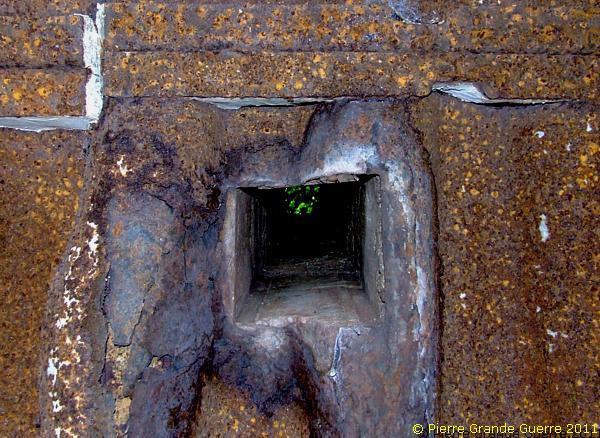
The southern "operating theatre".
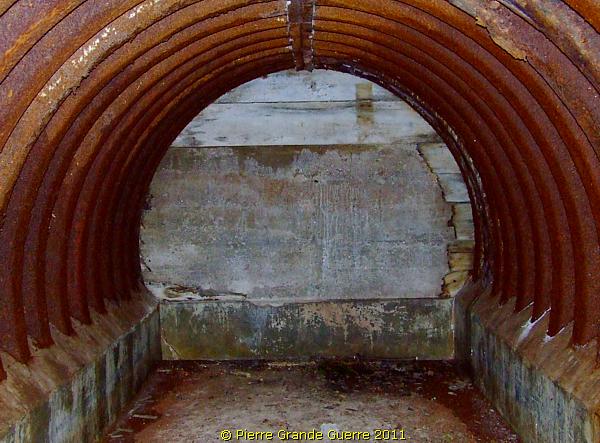
We continue our exploration through the eastern tunnel, ...
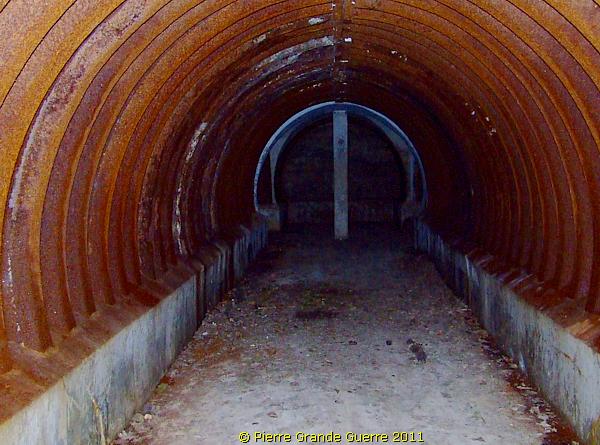
... on our way to the eastern exit.
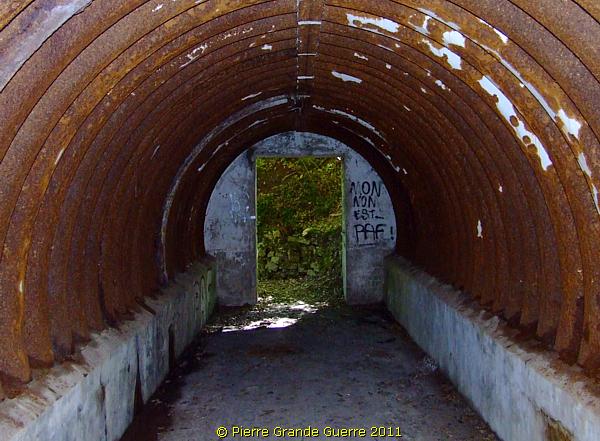
The eastern exit, photographed from the outside.
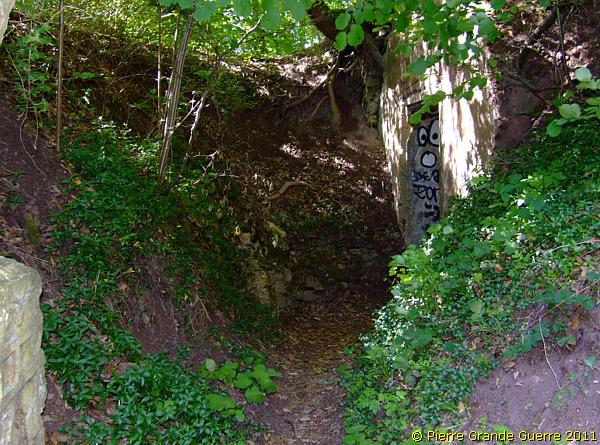
The outer concrete wall, that protects the eastern exit, forms not only the start but also the end of our exploration of this French dressing station near Domjevin.
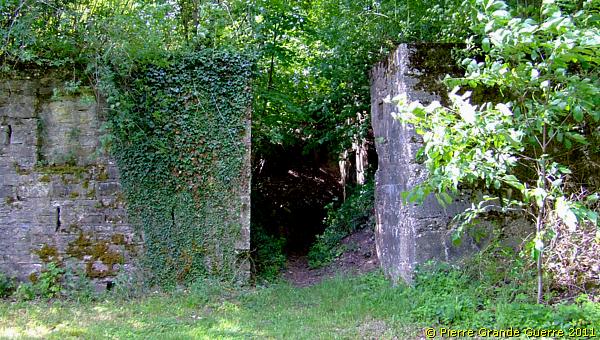
Satisfied after such an interesting day we return to our car.

For more explorations over the Lorraine battlefields, please, click on the link below for the next Photo Impression.
Continue to the next chapter on Lorraine: " Avricourt - Leintrey - Reillon - Domèvre - Parux "






